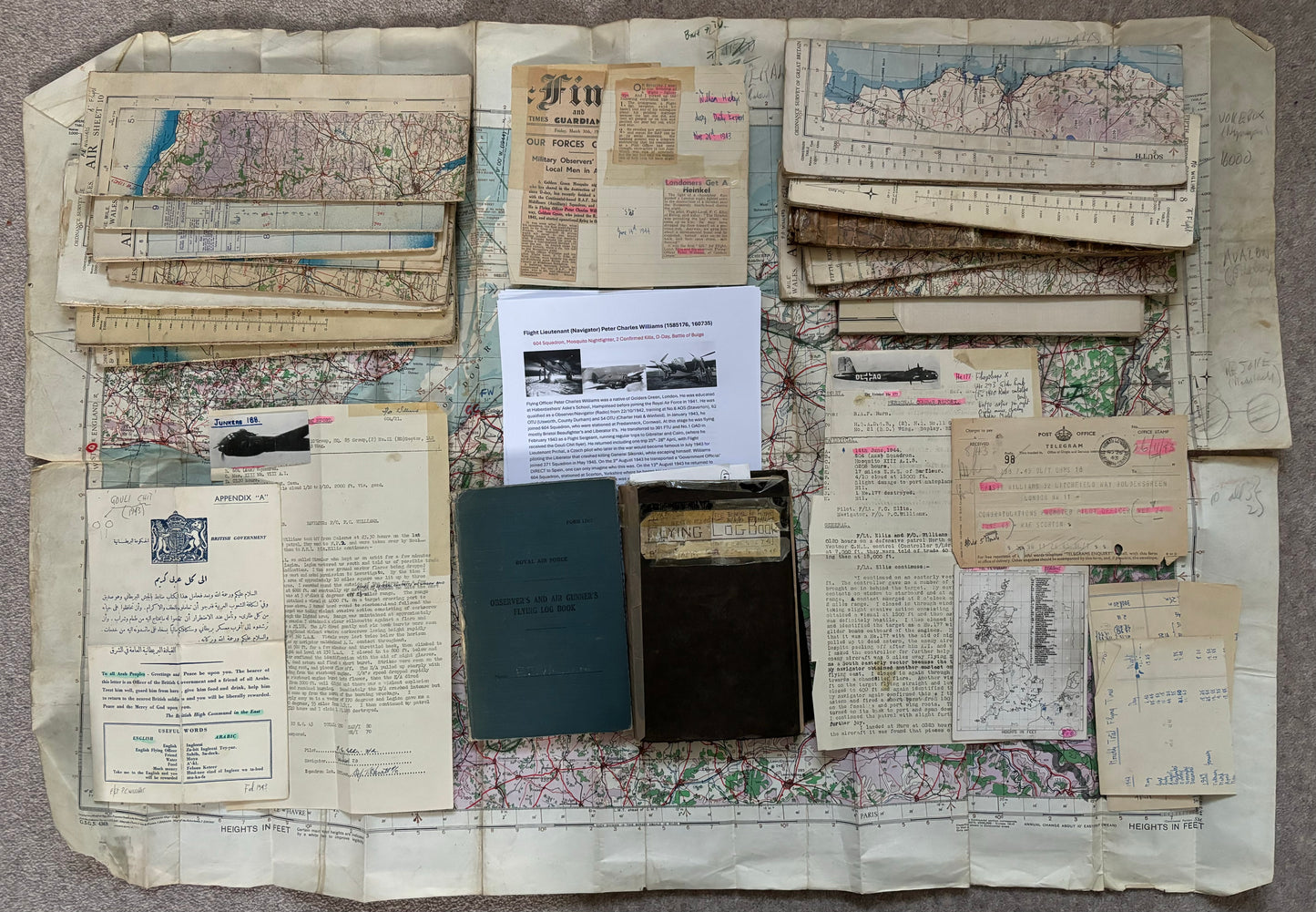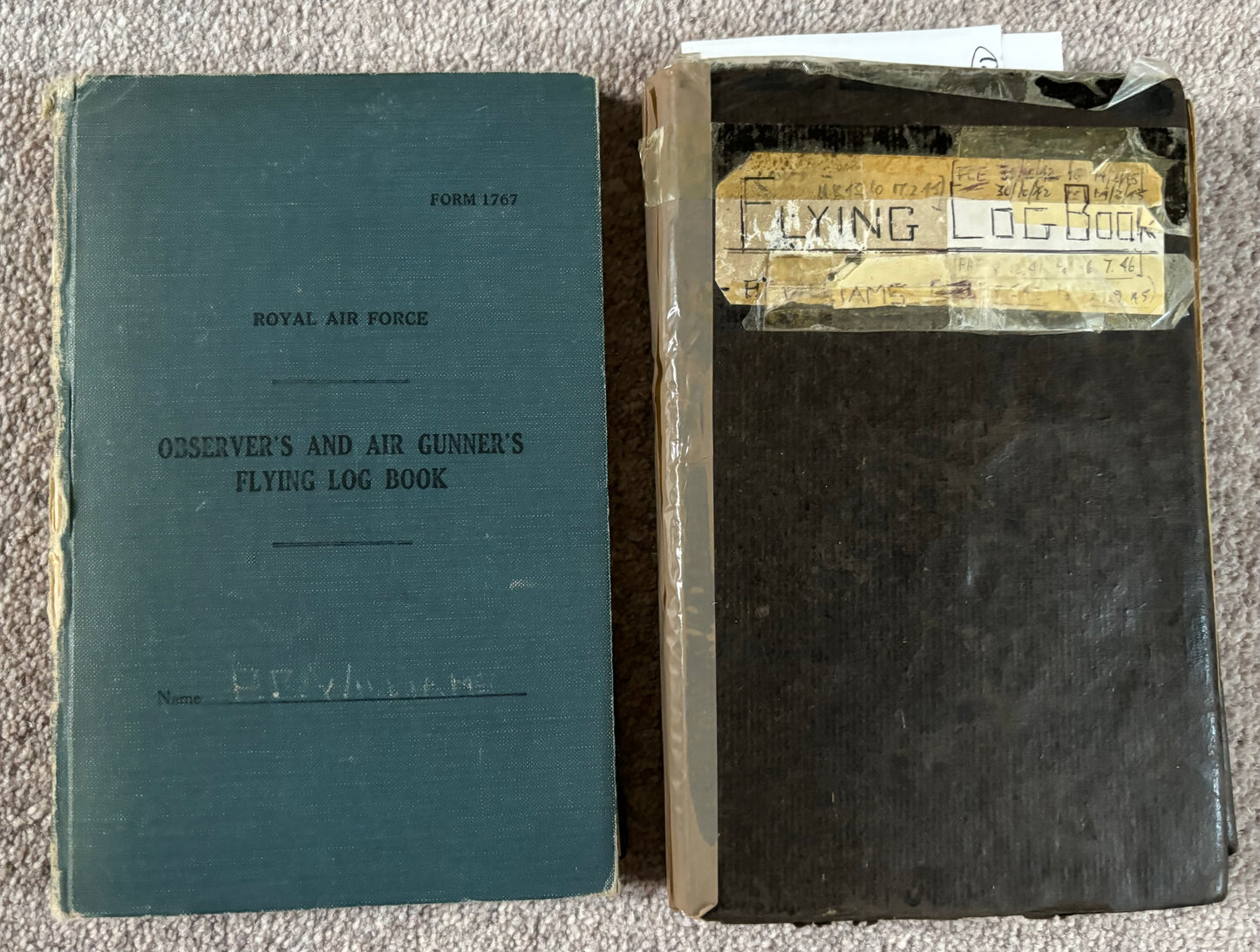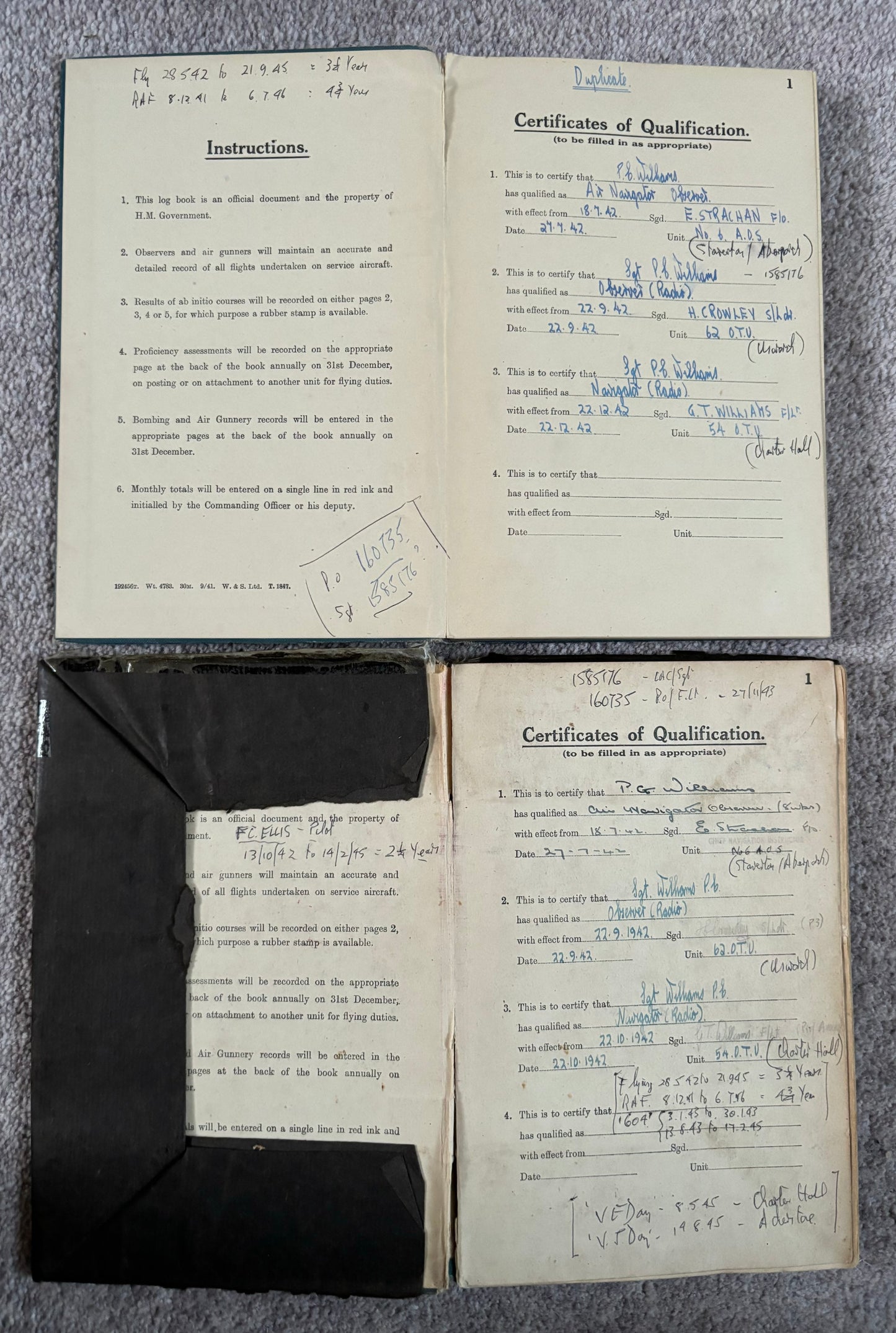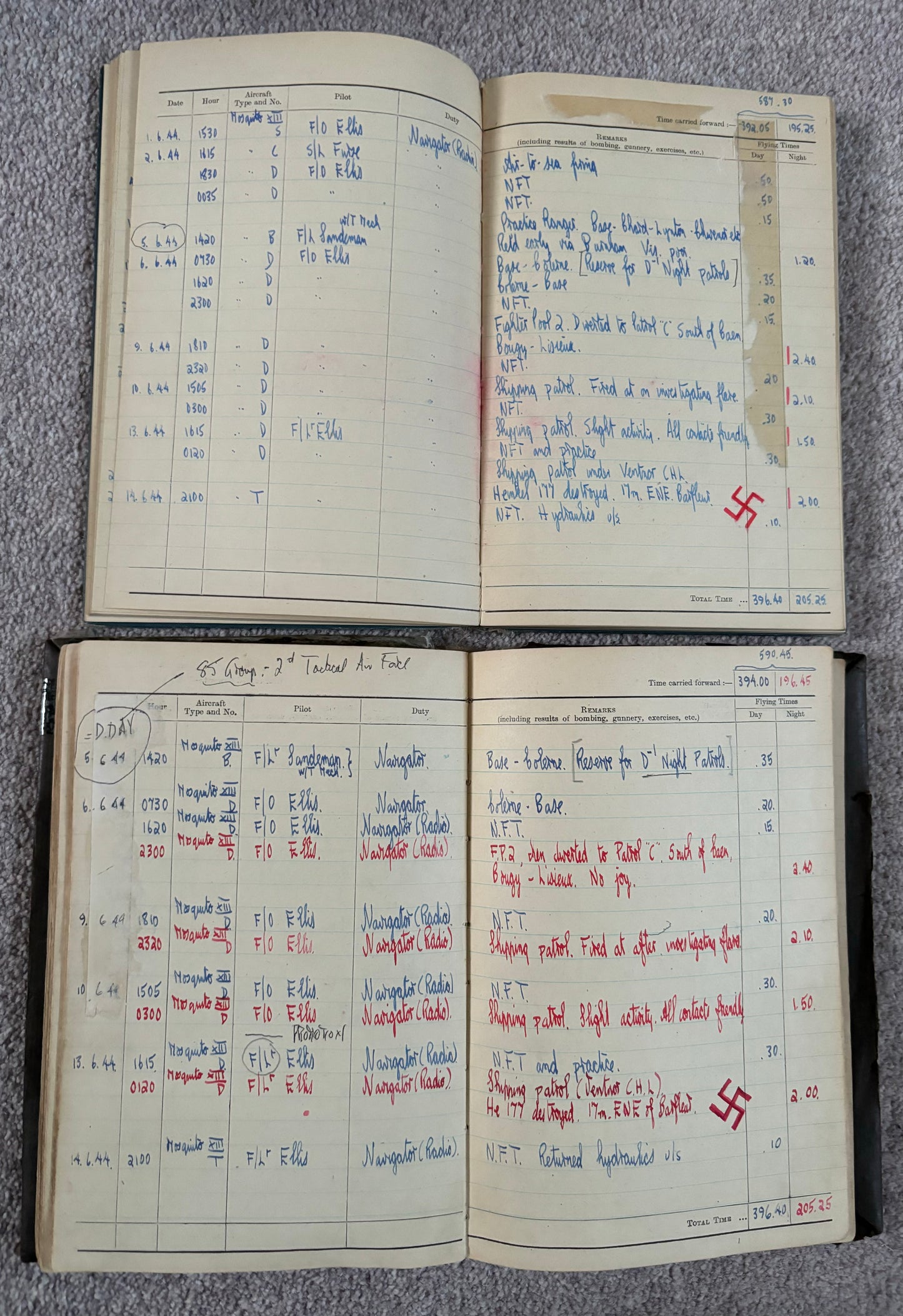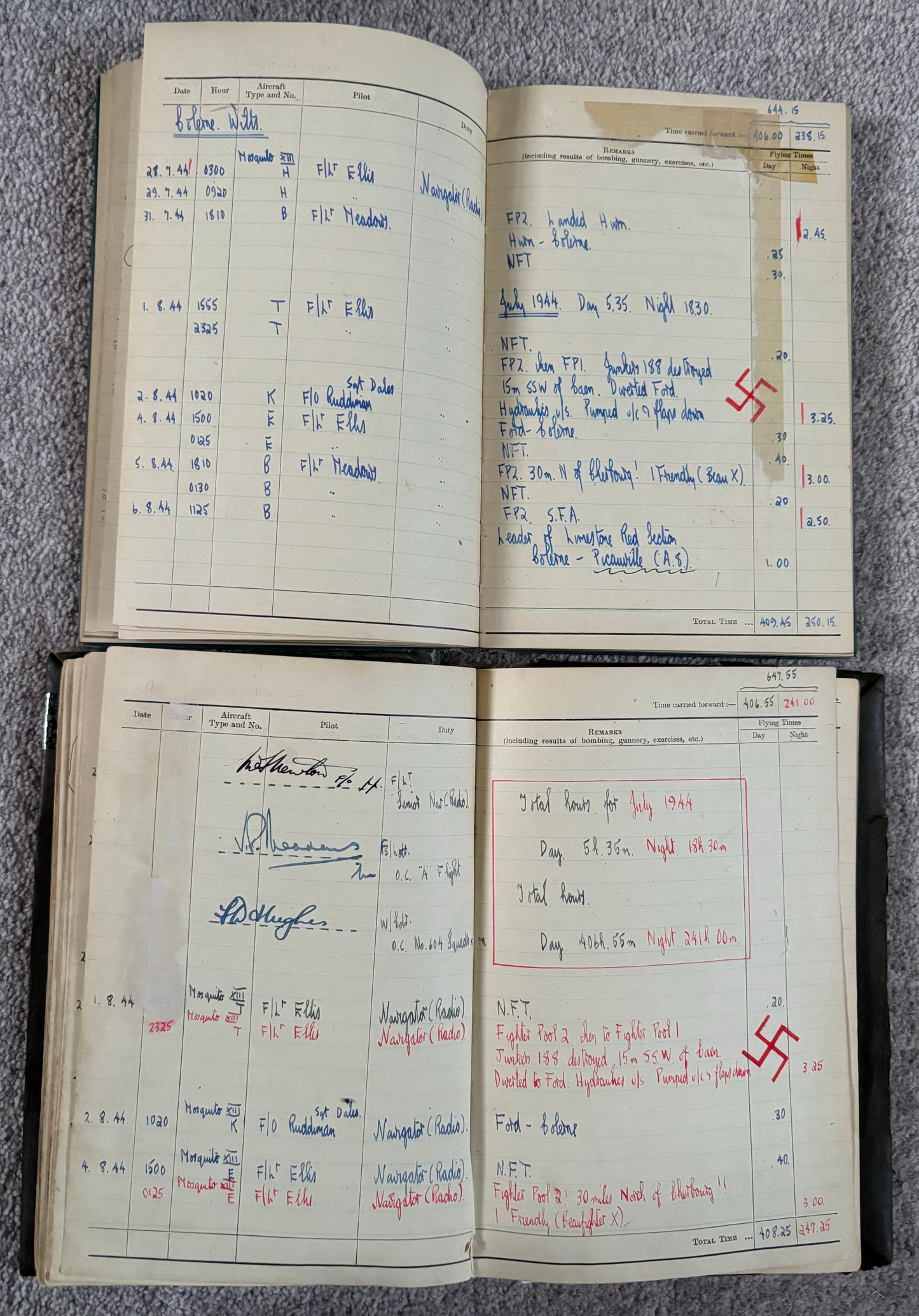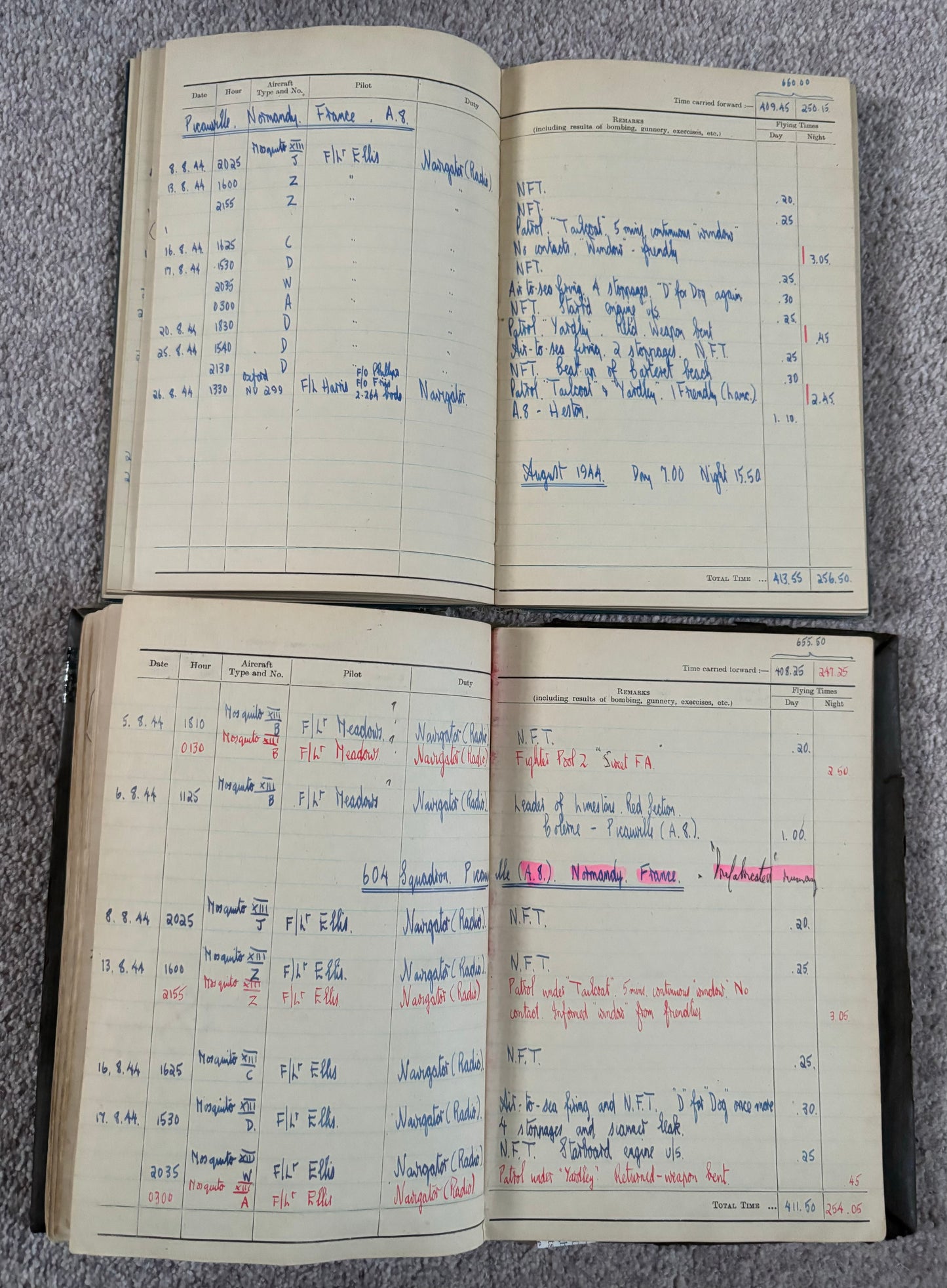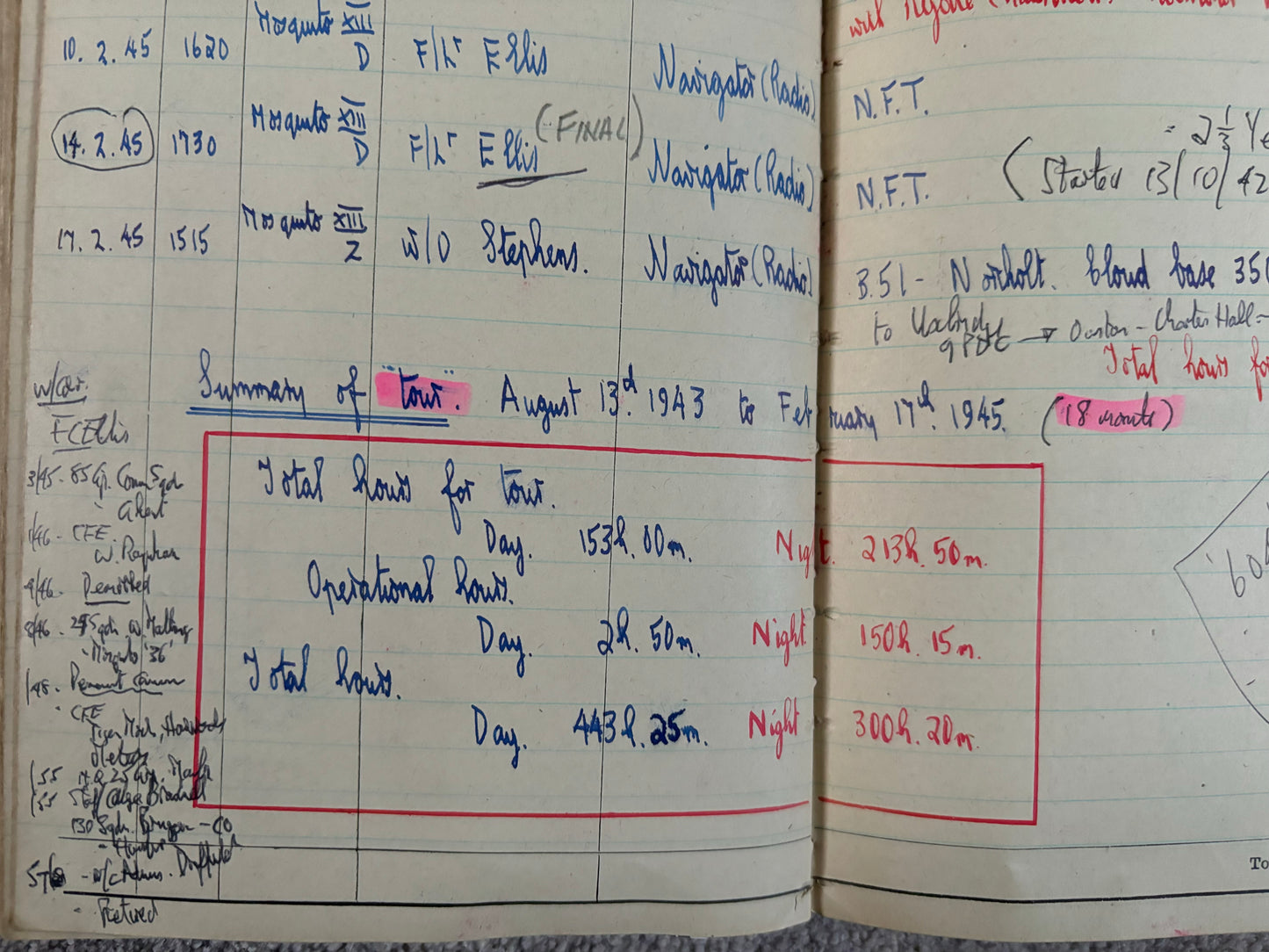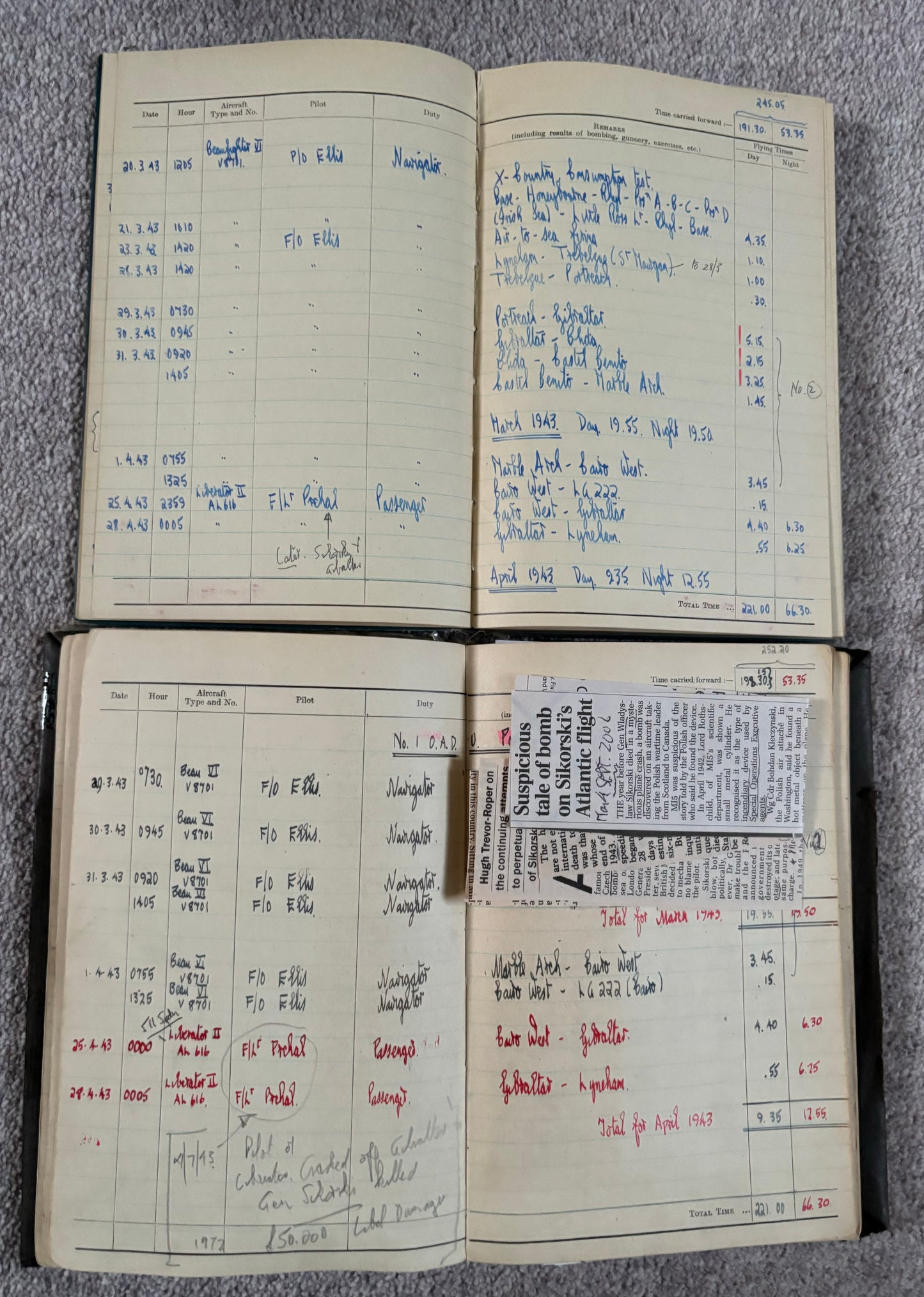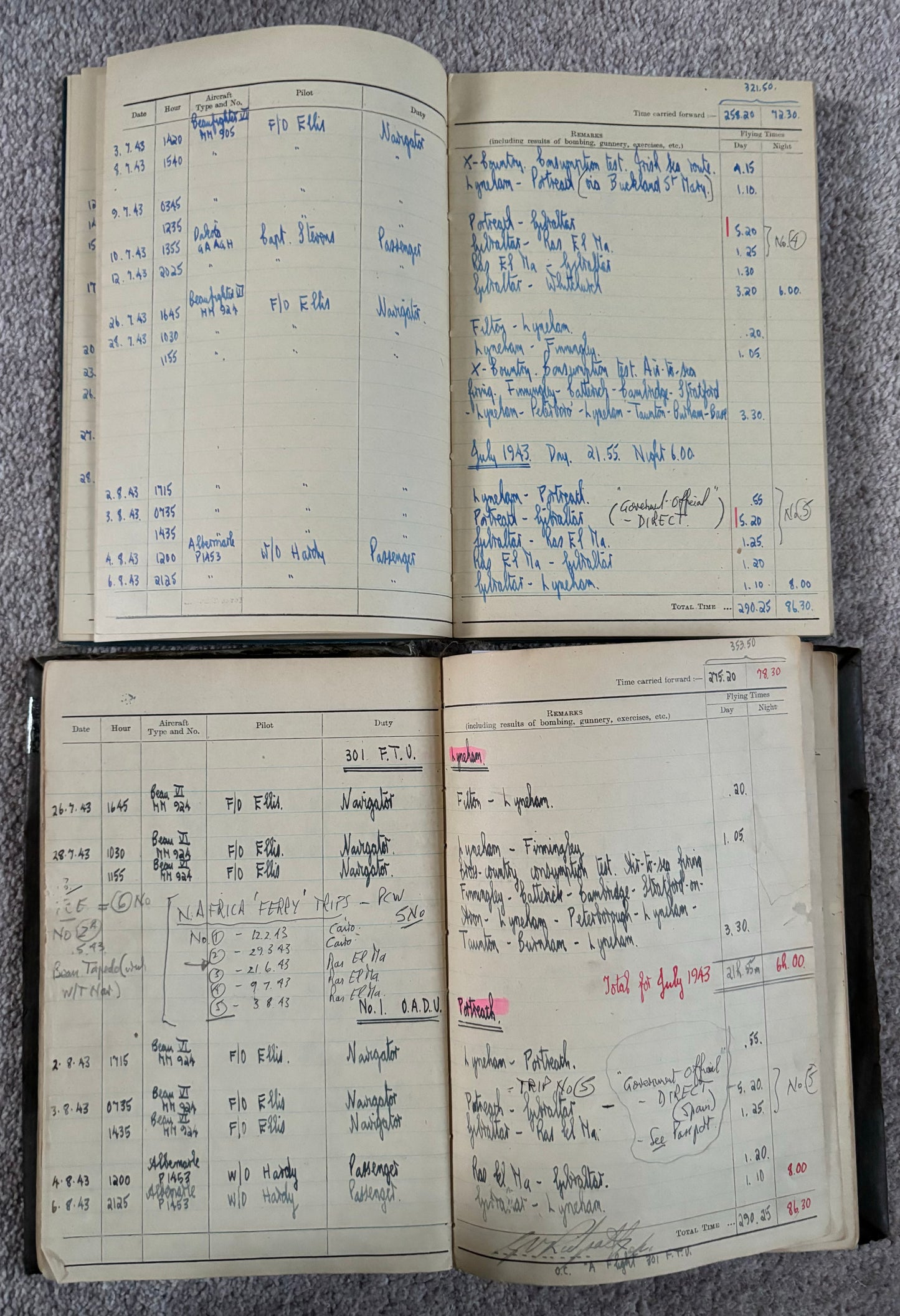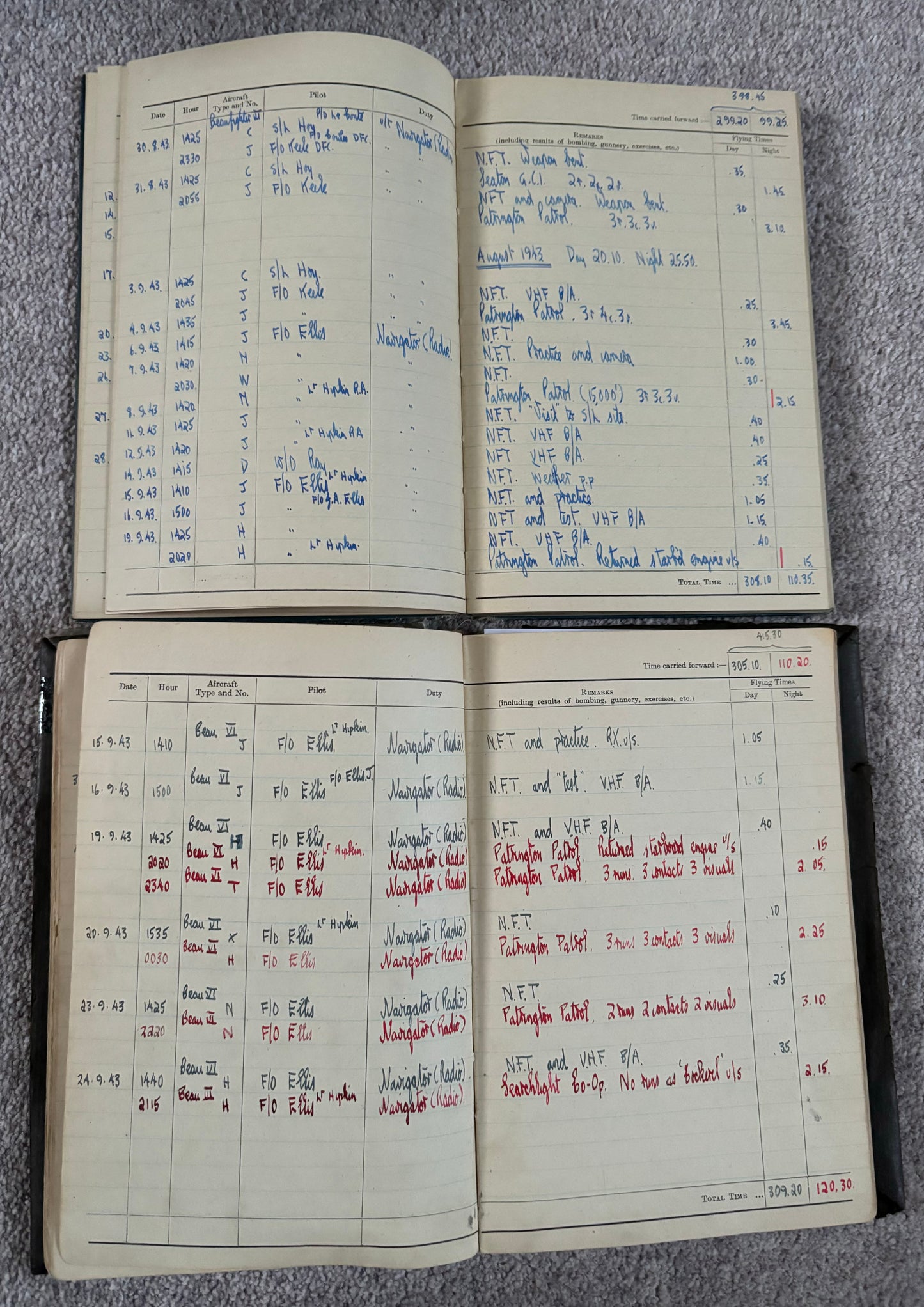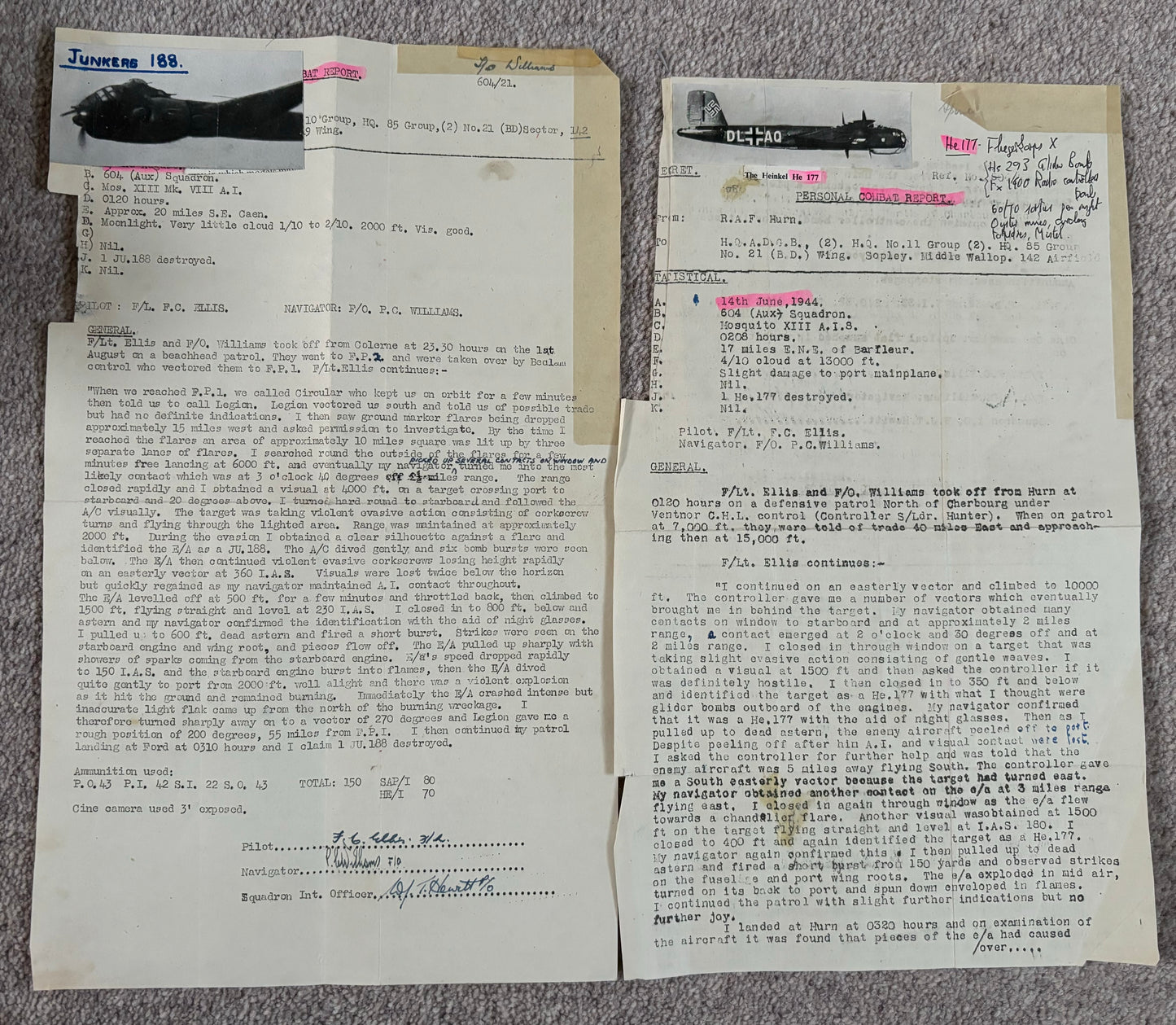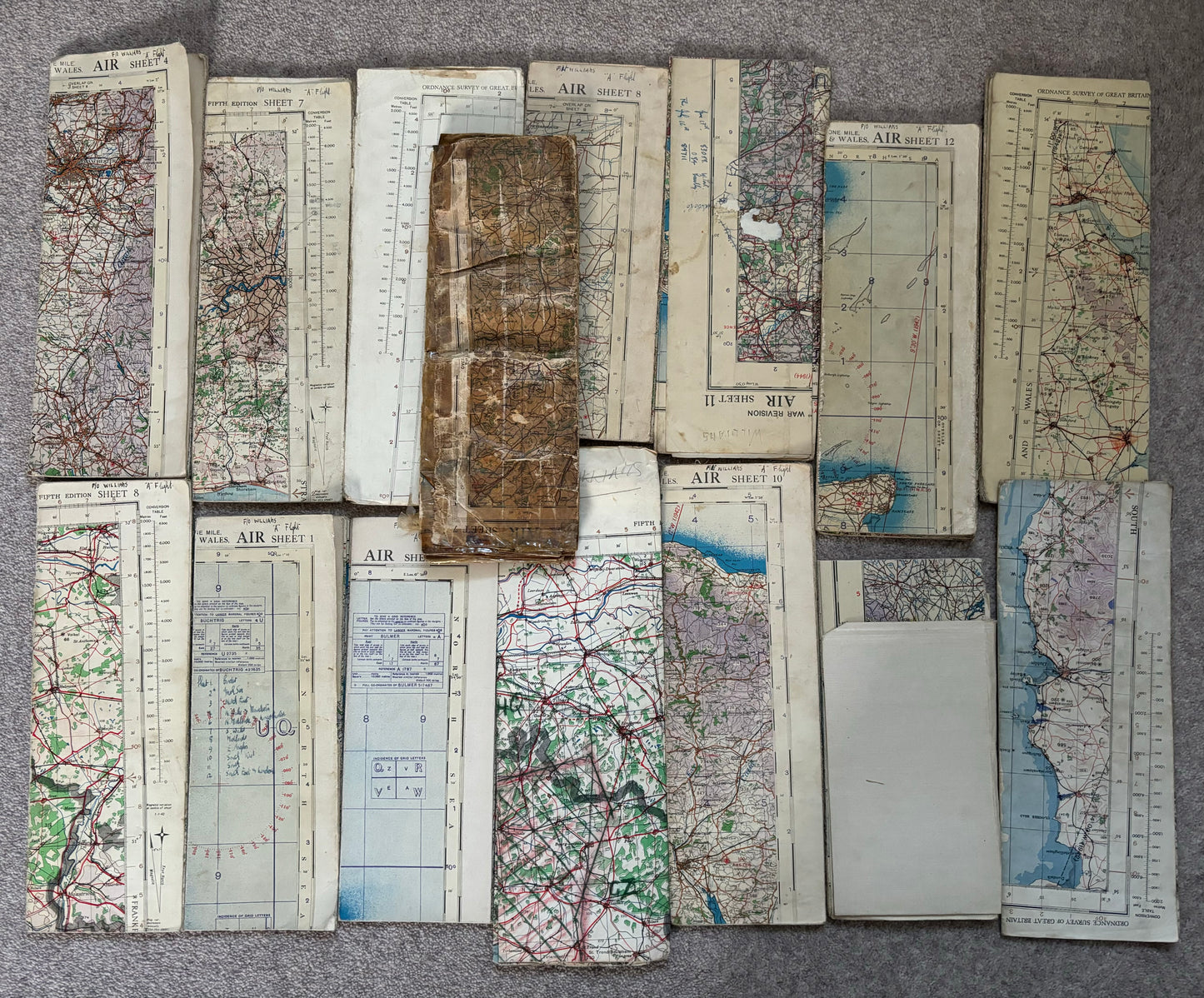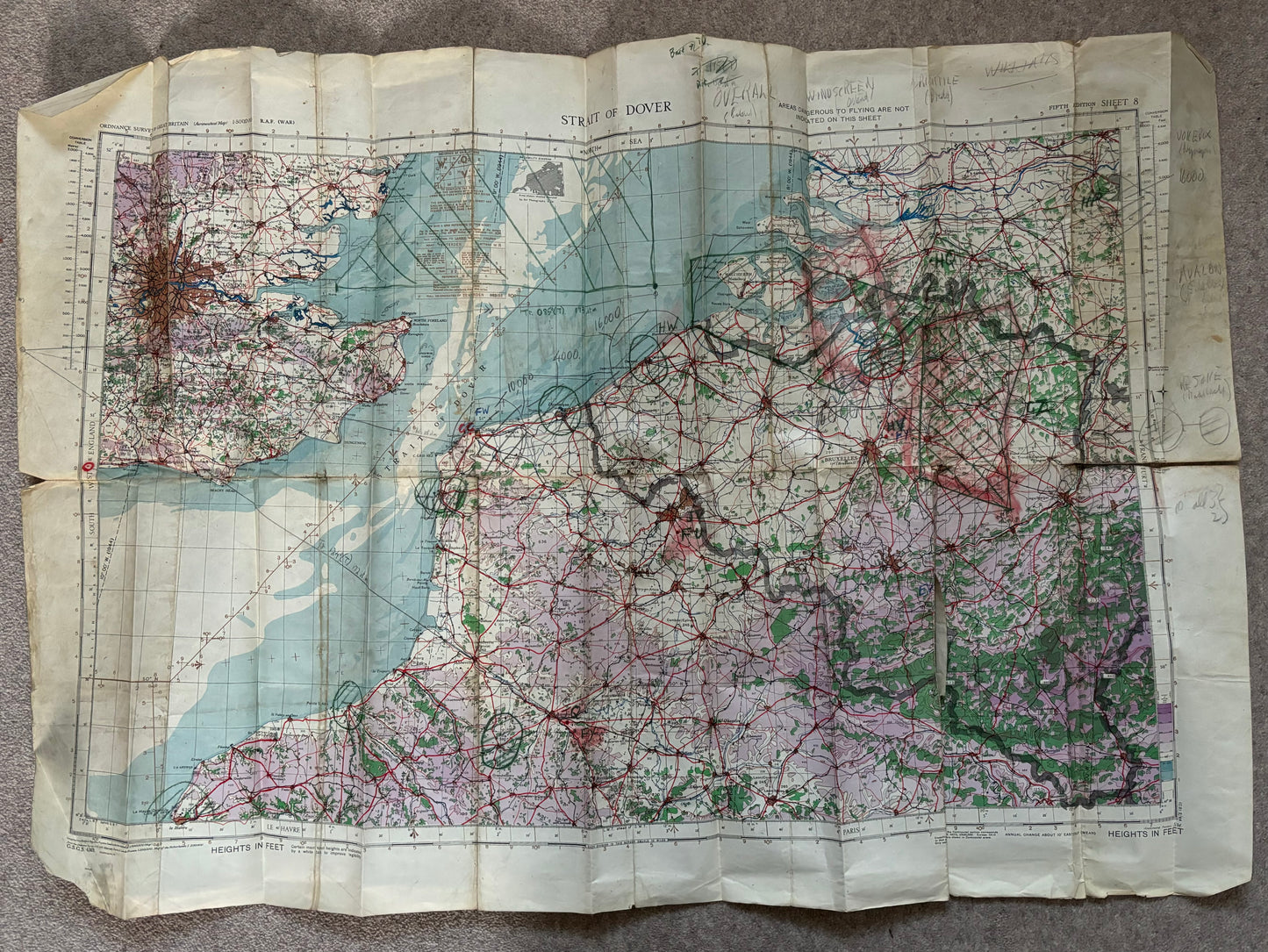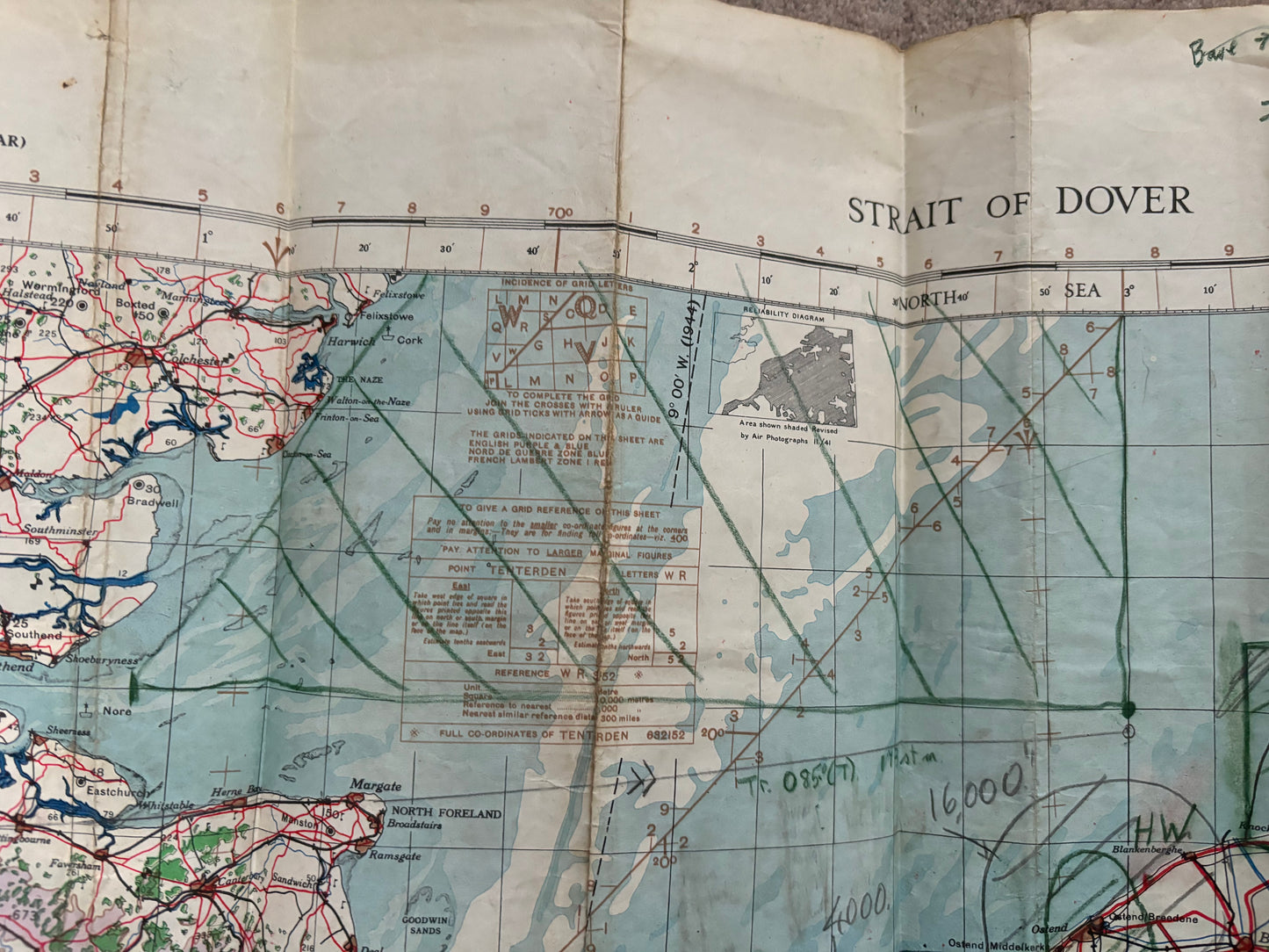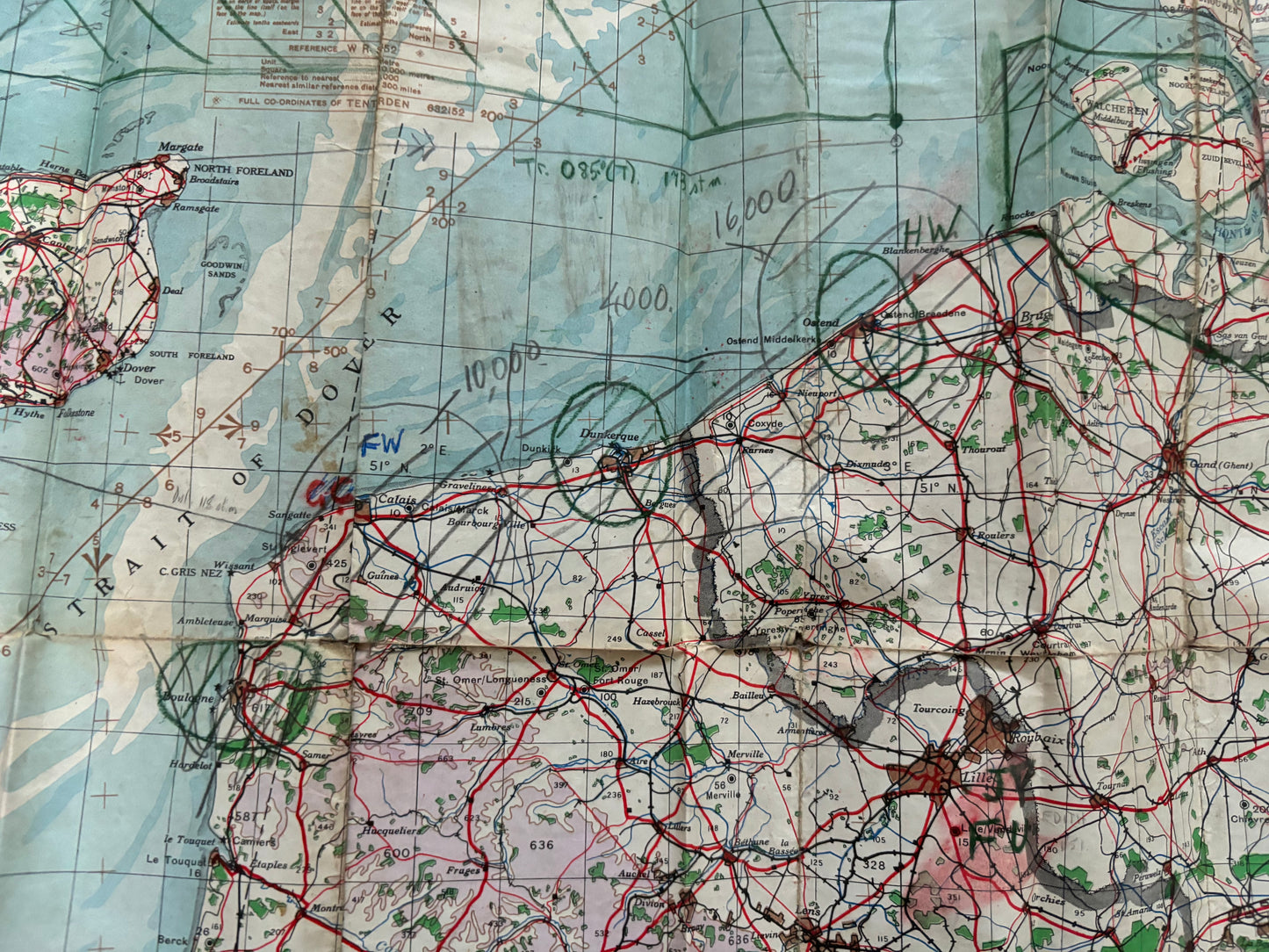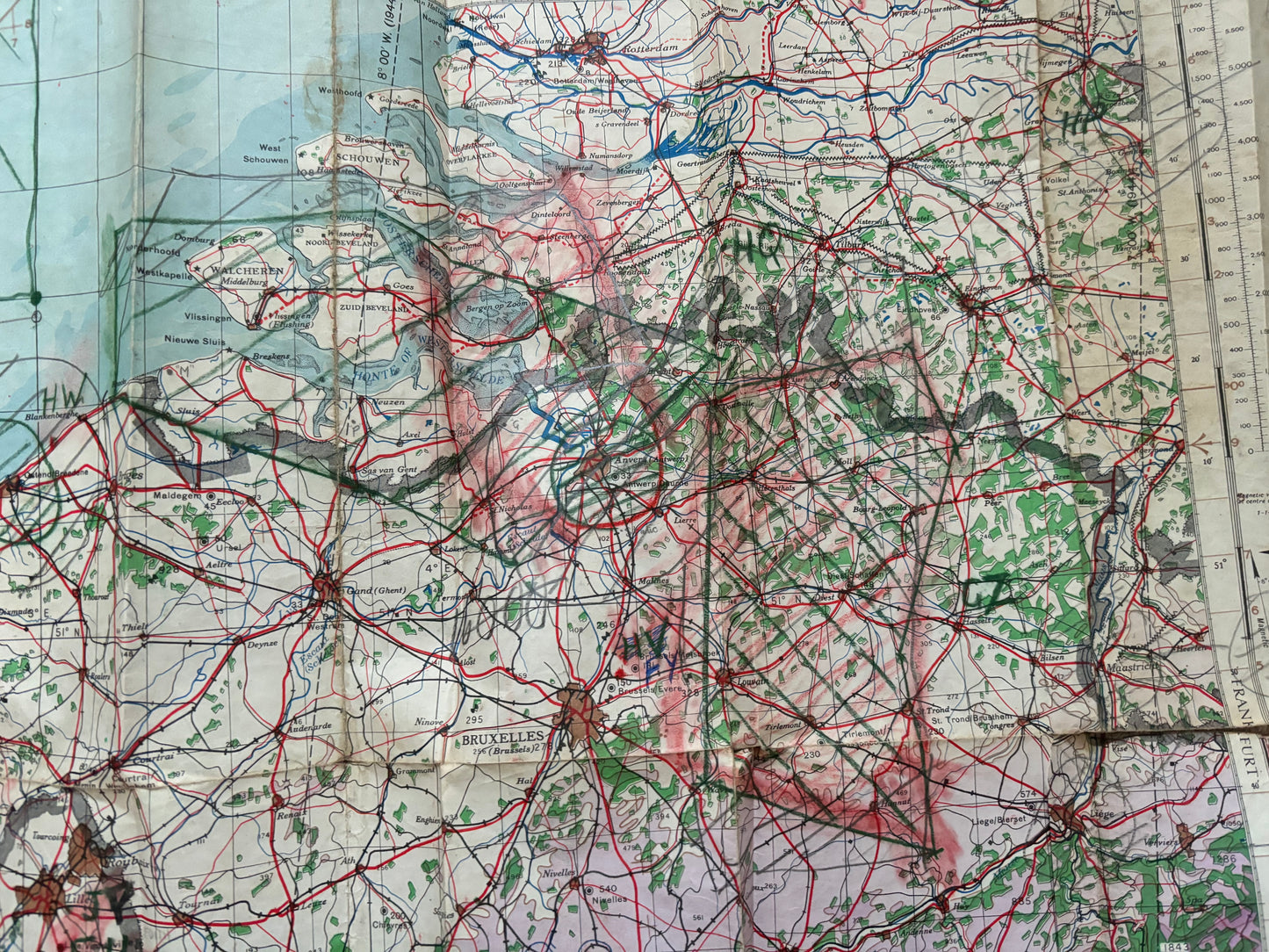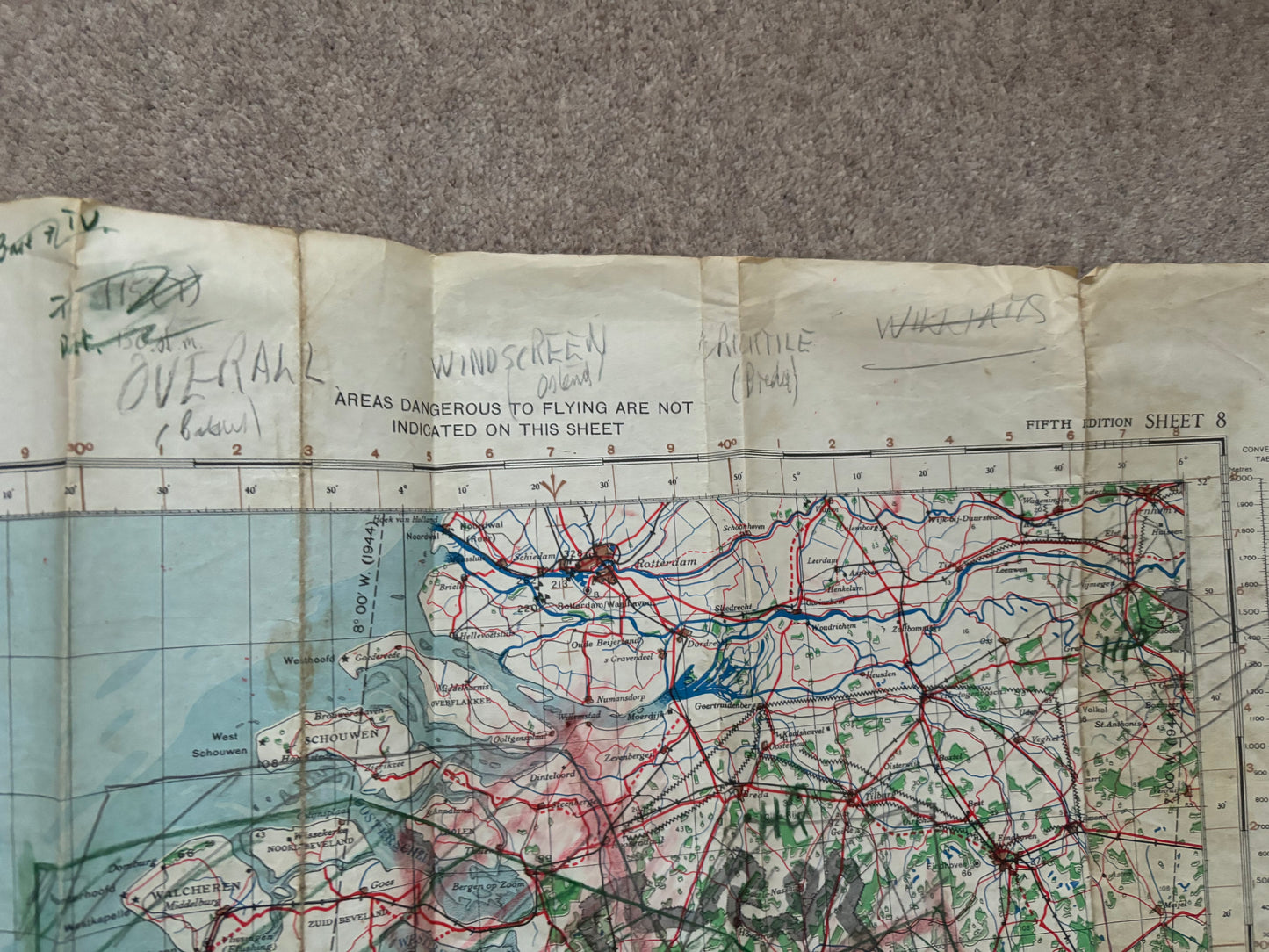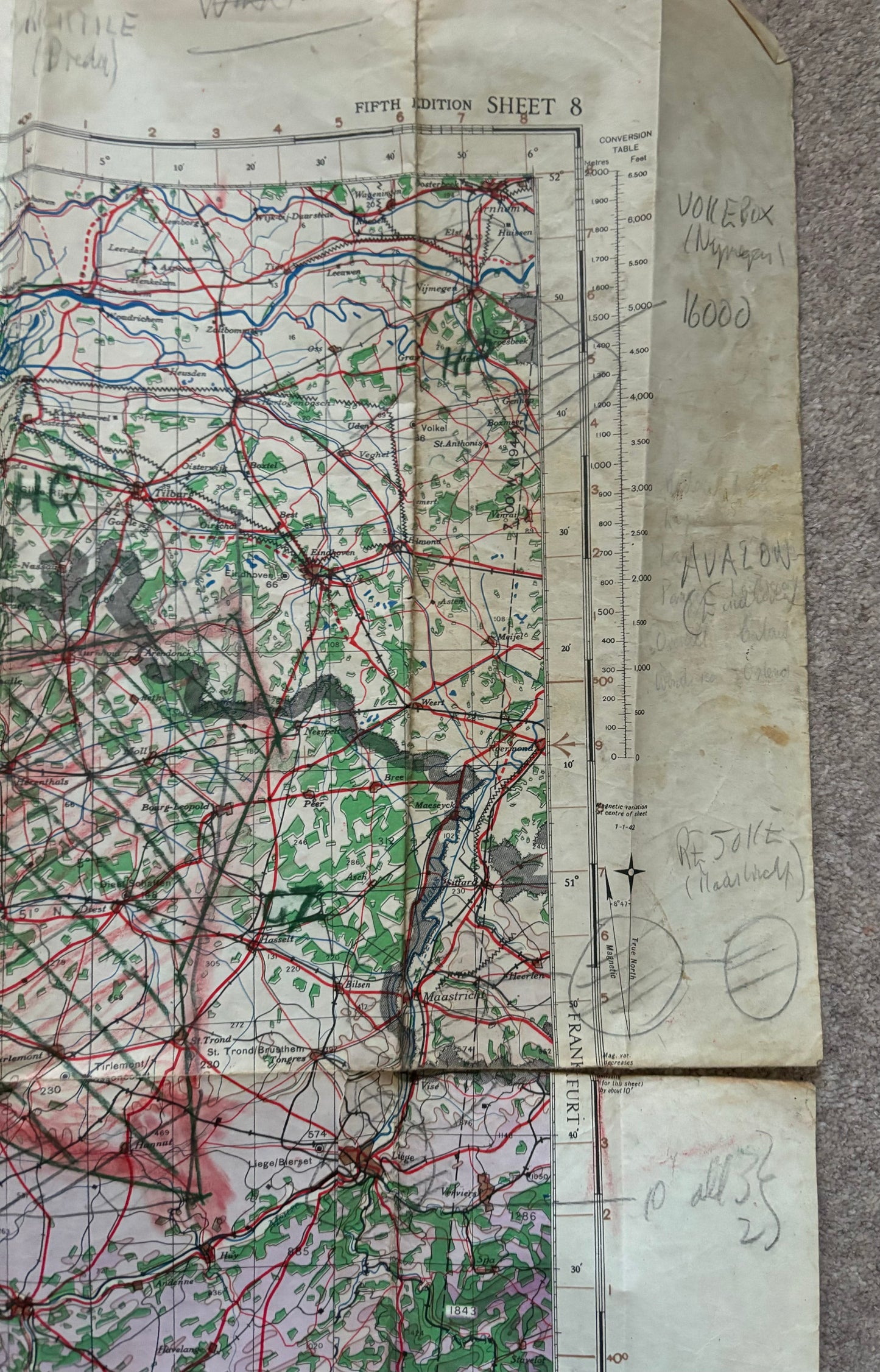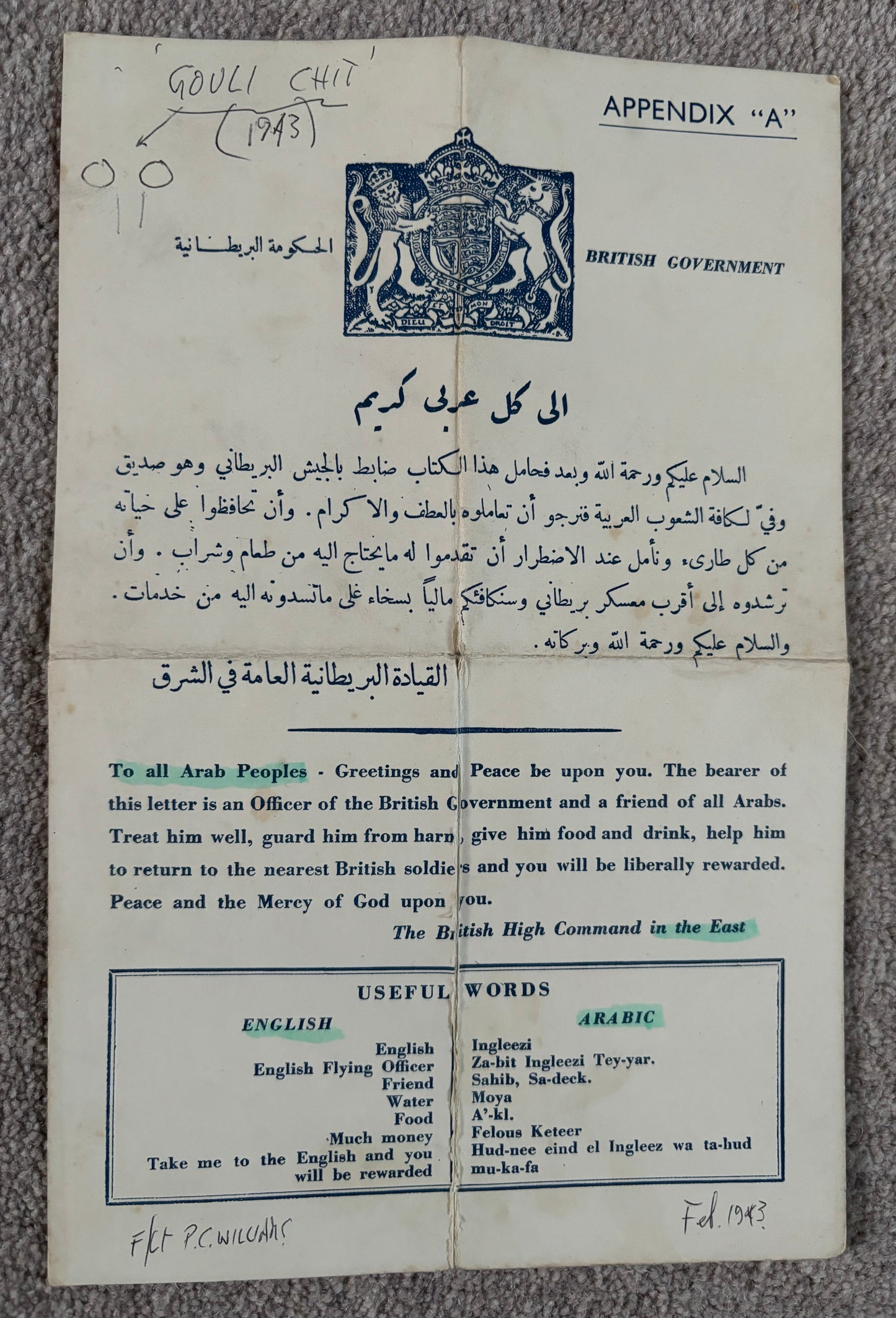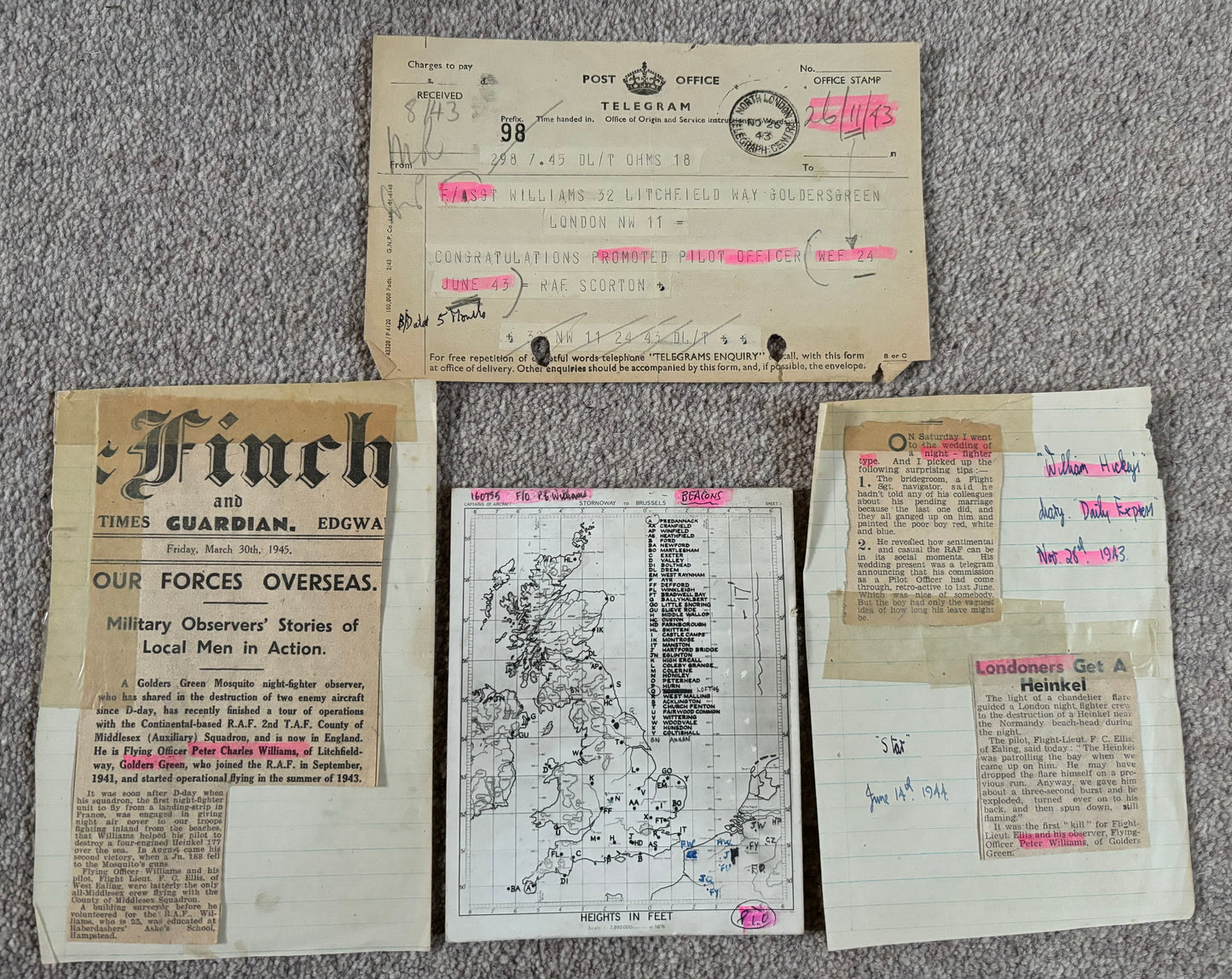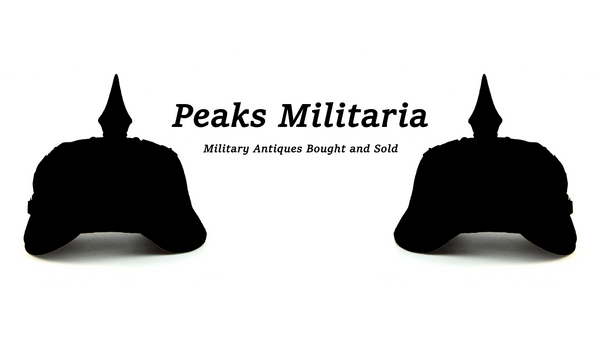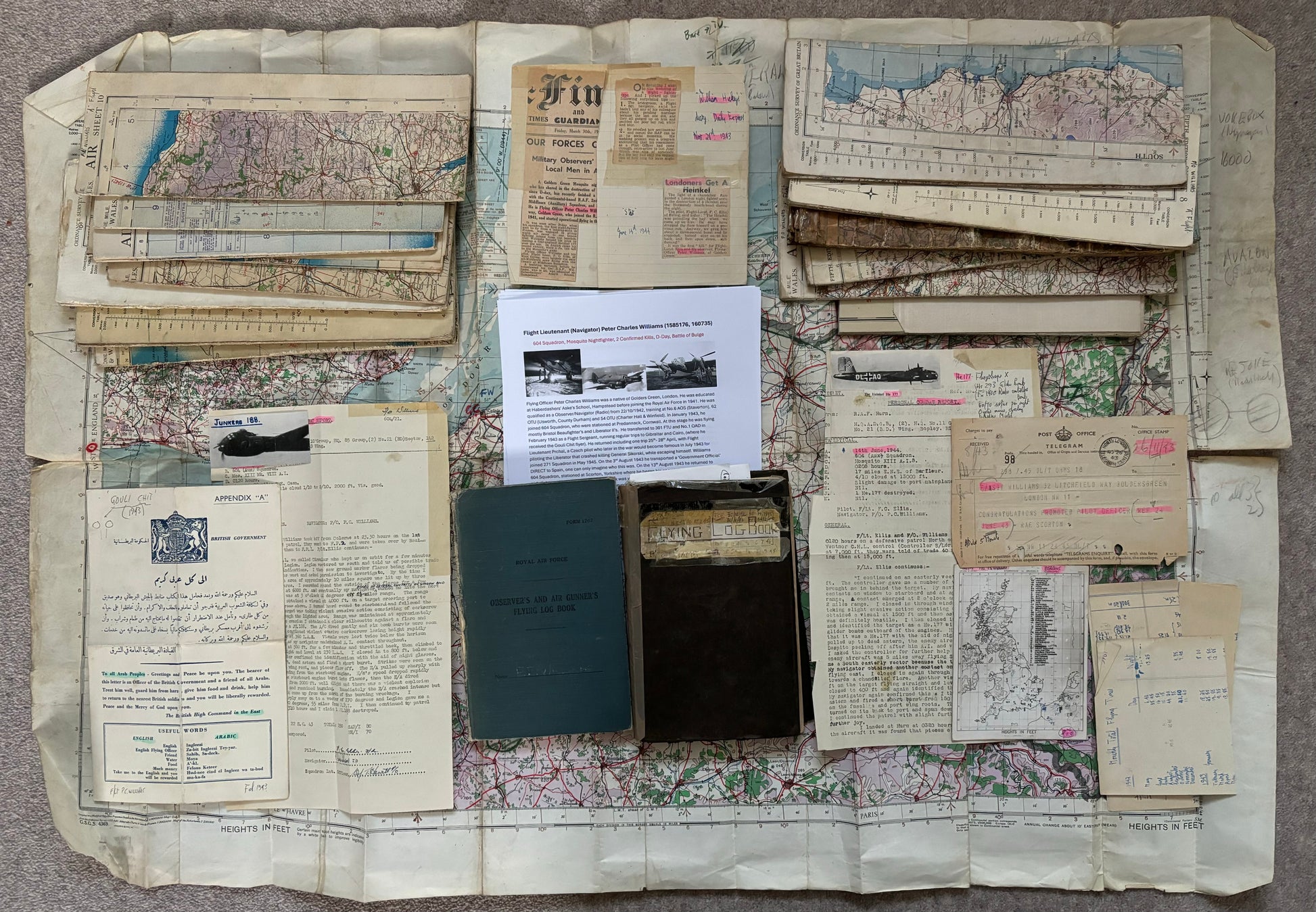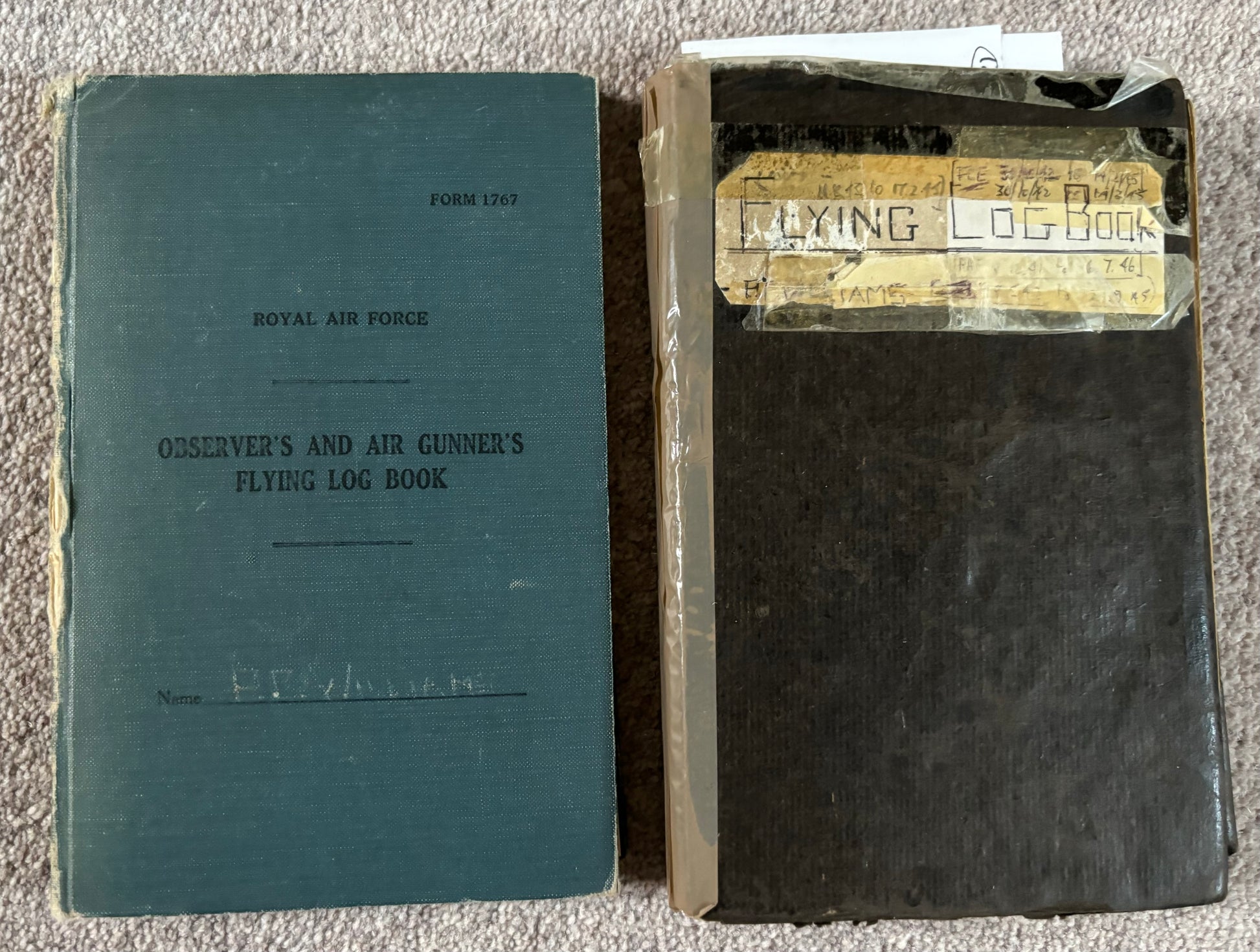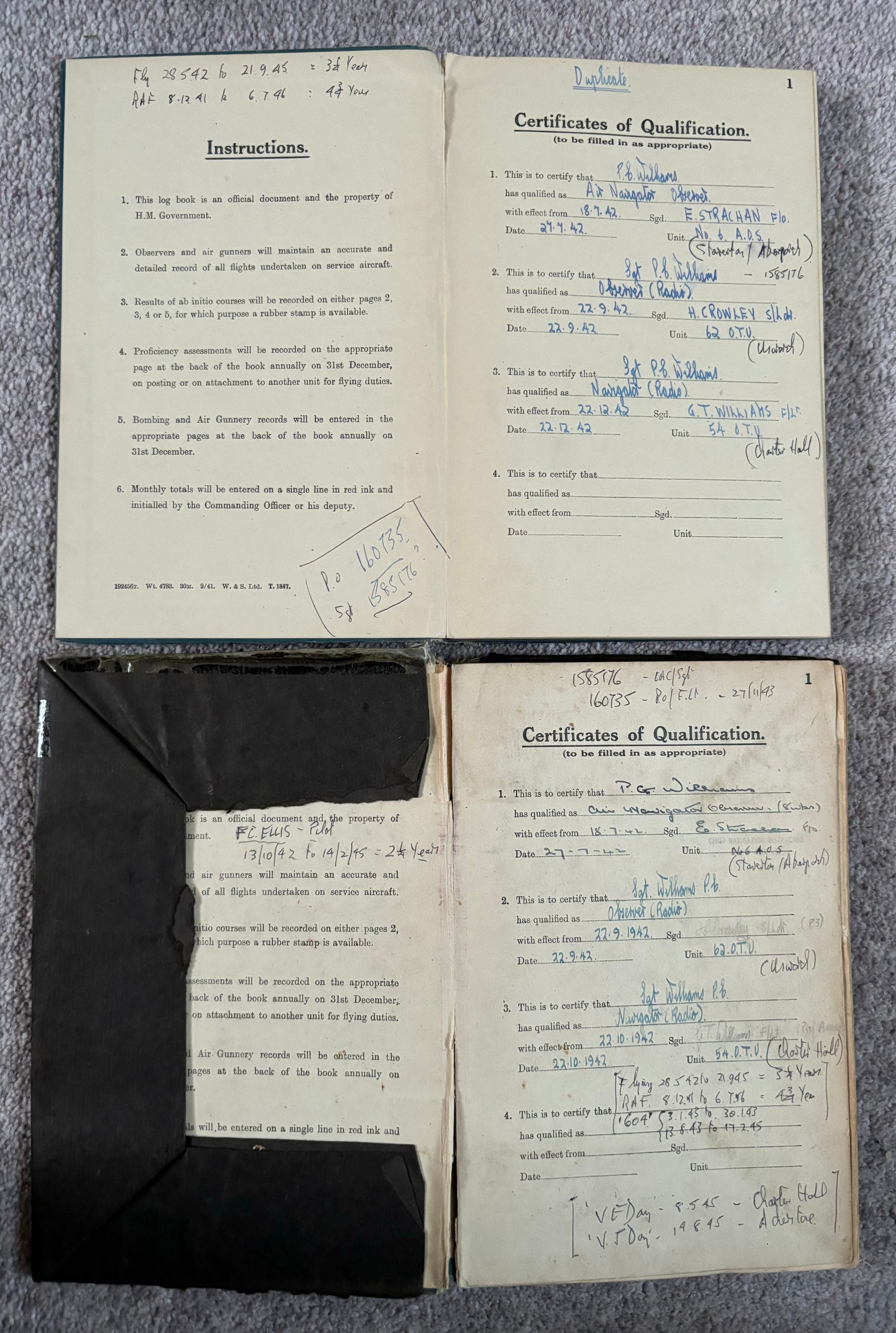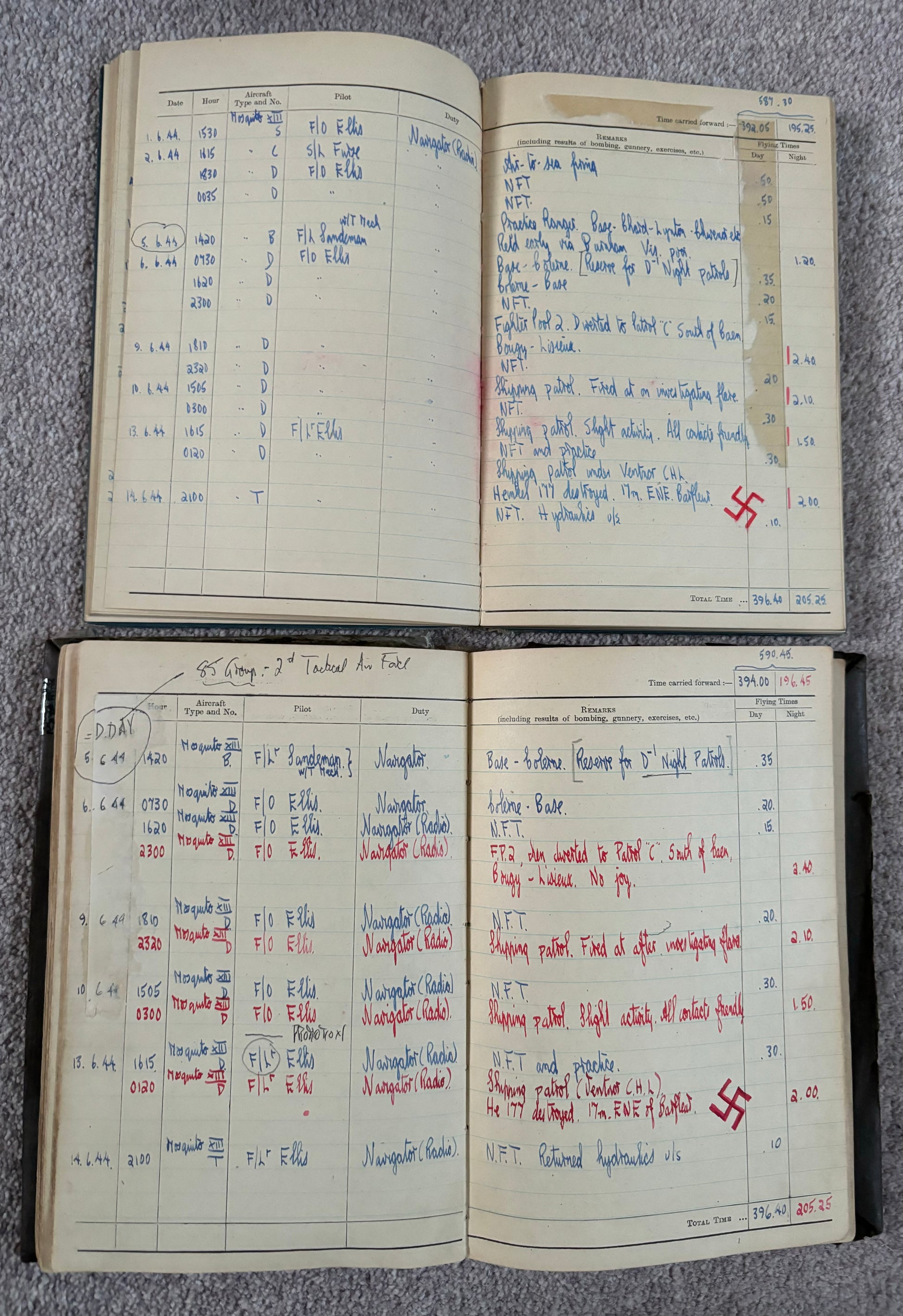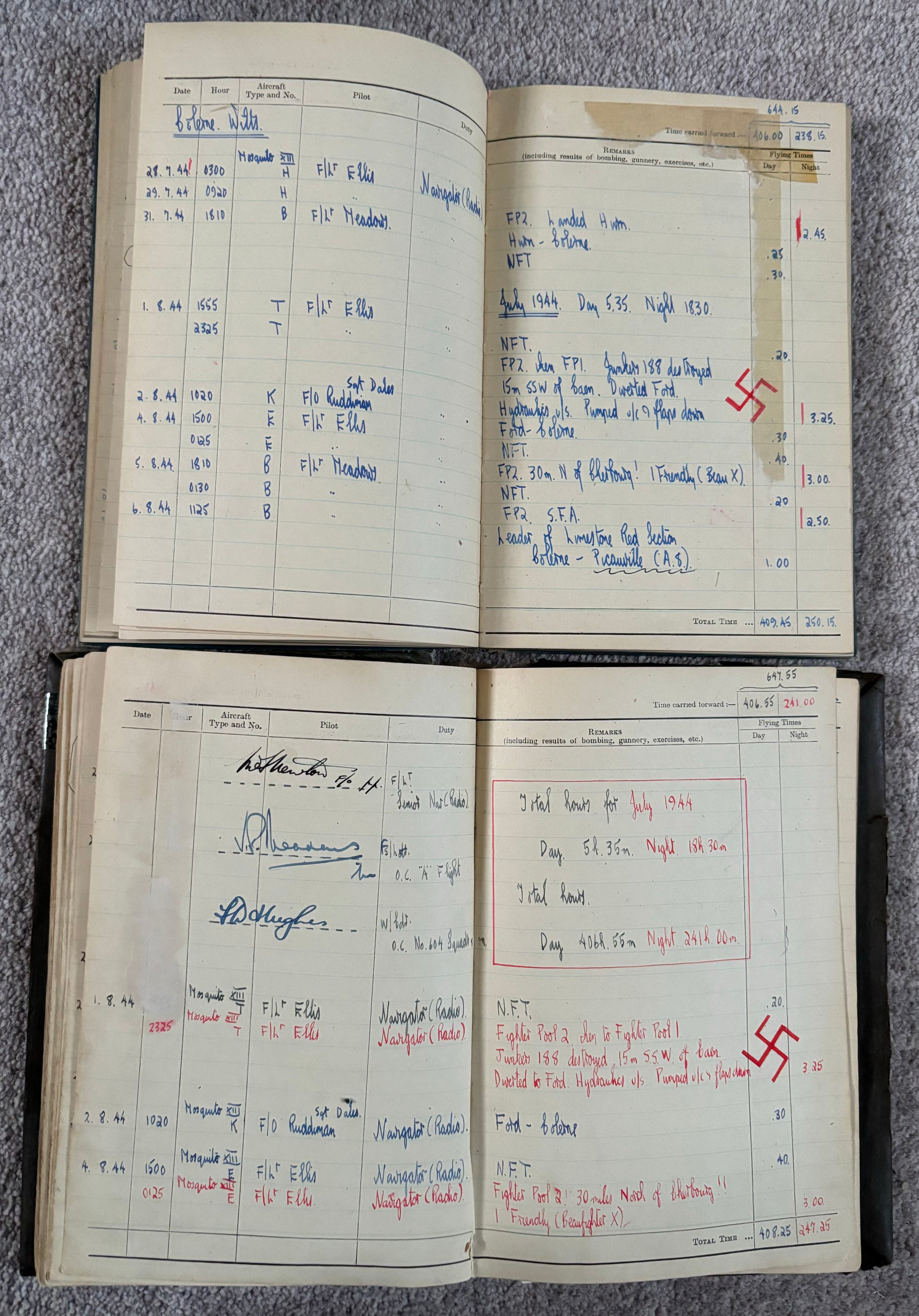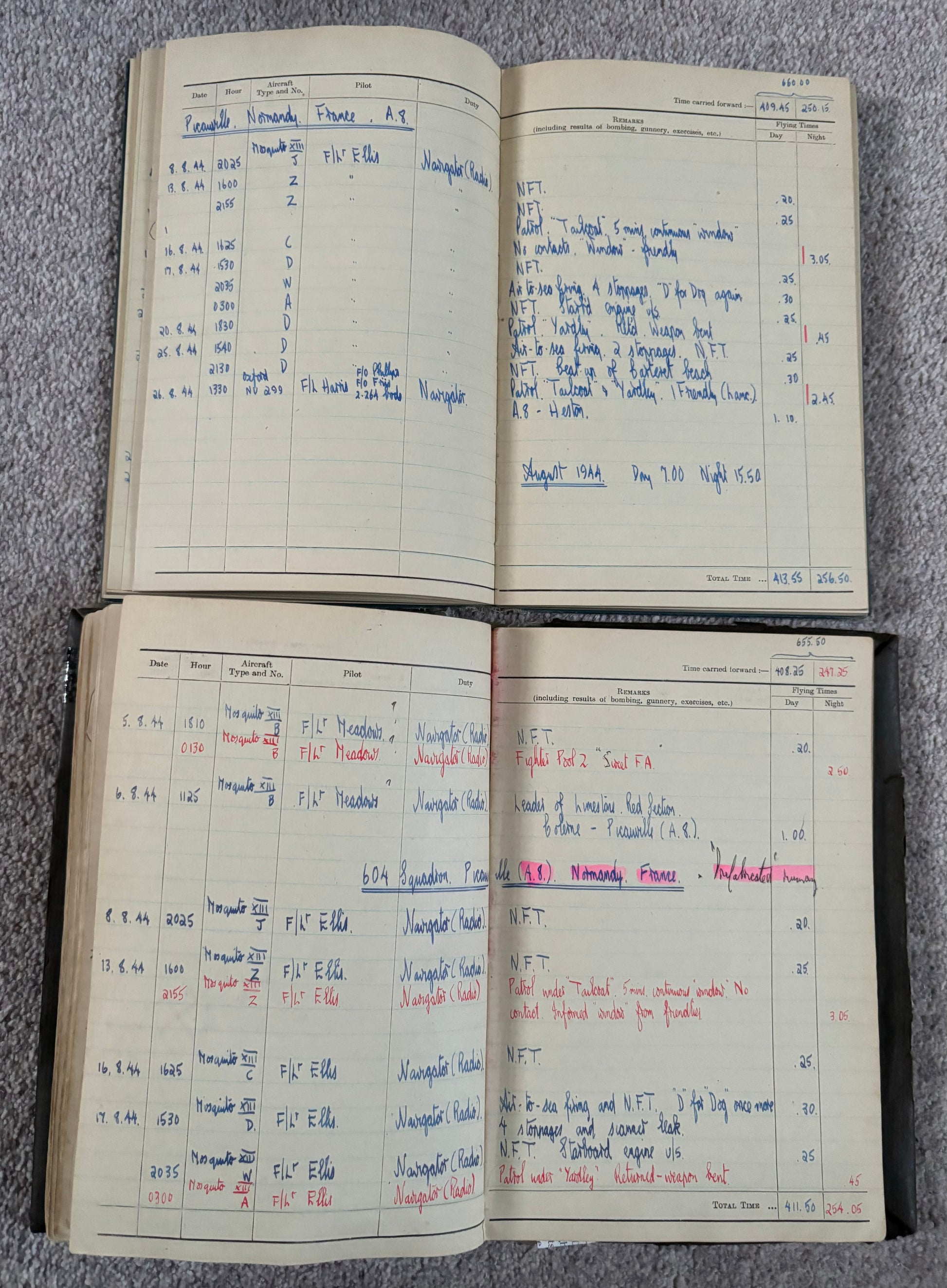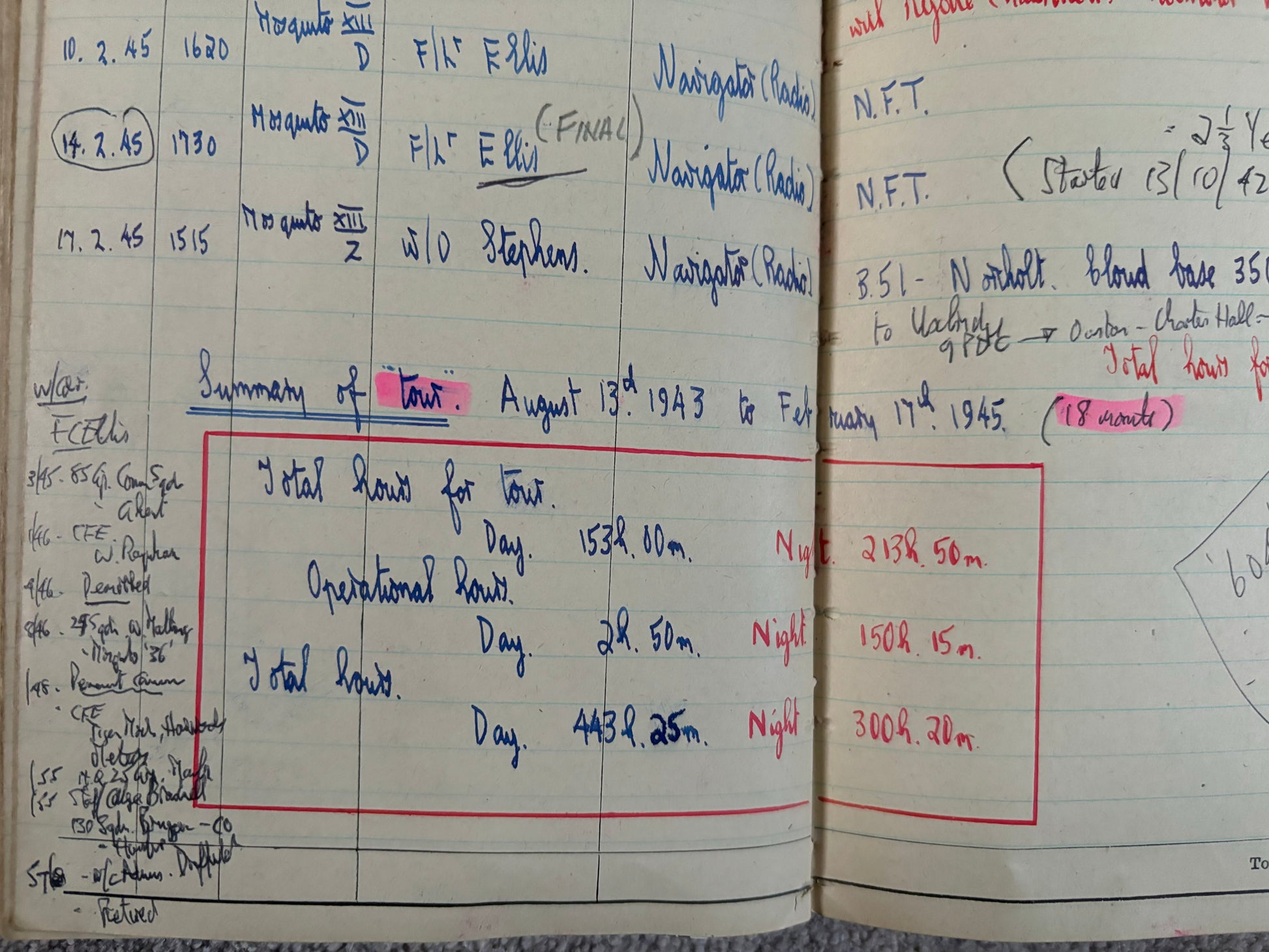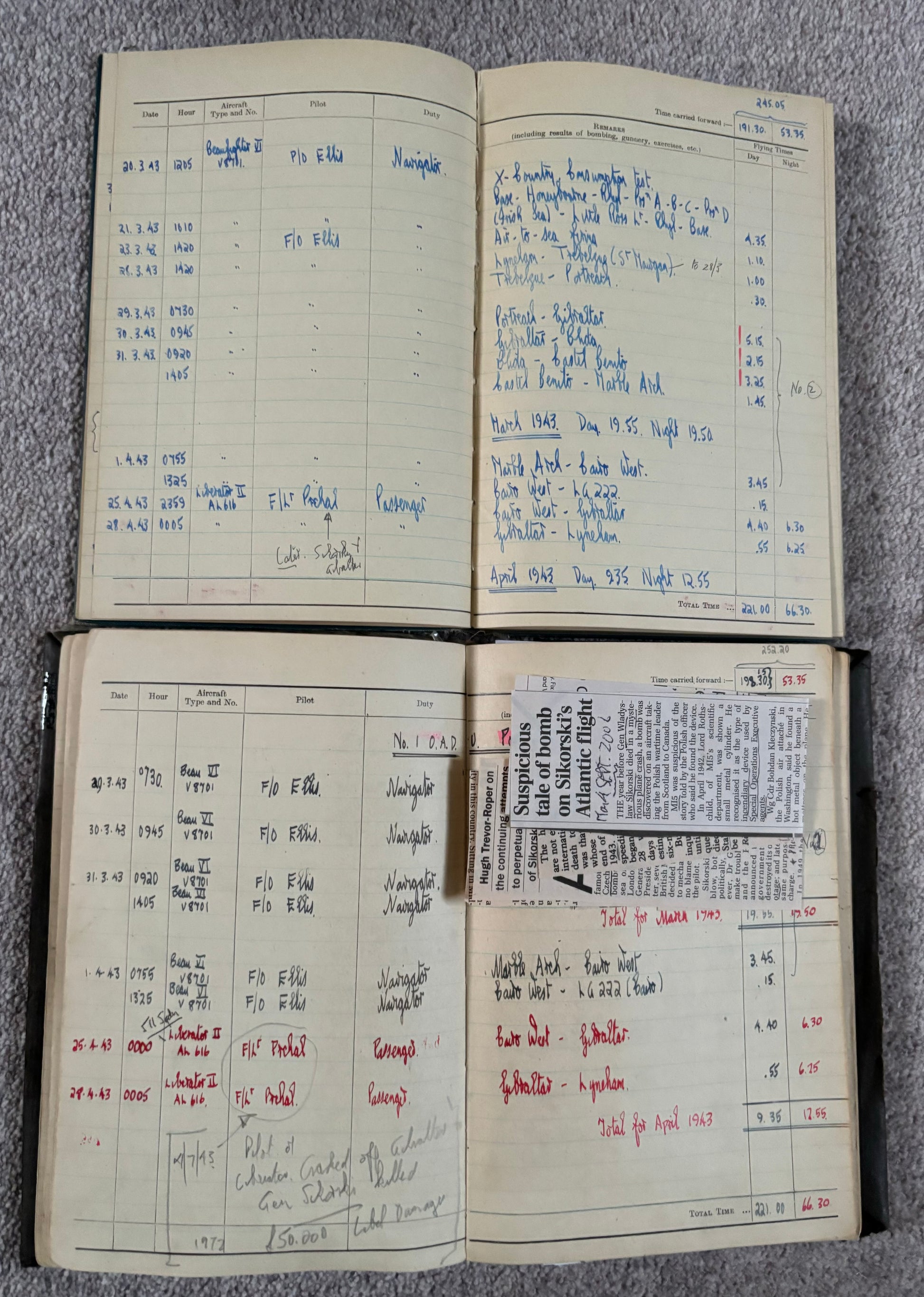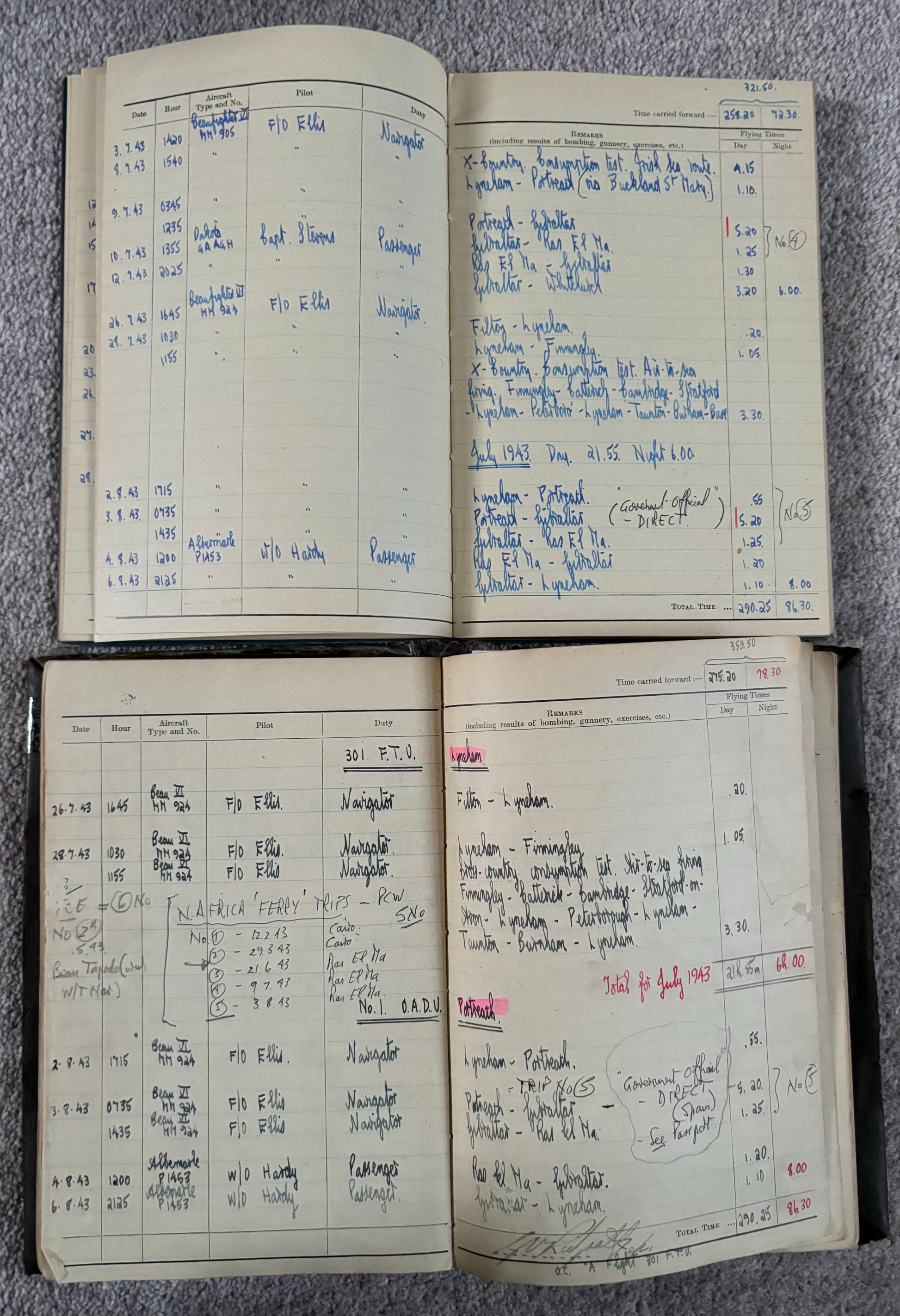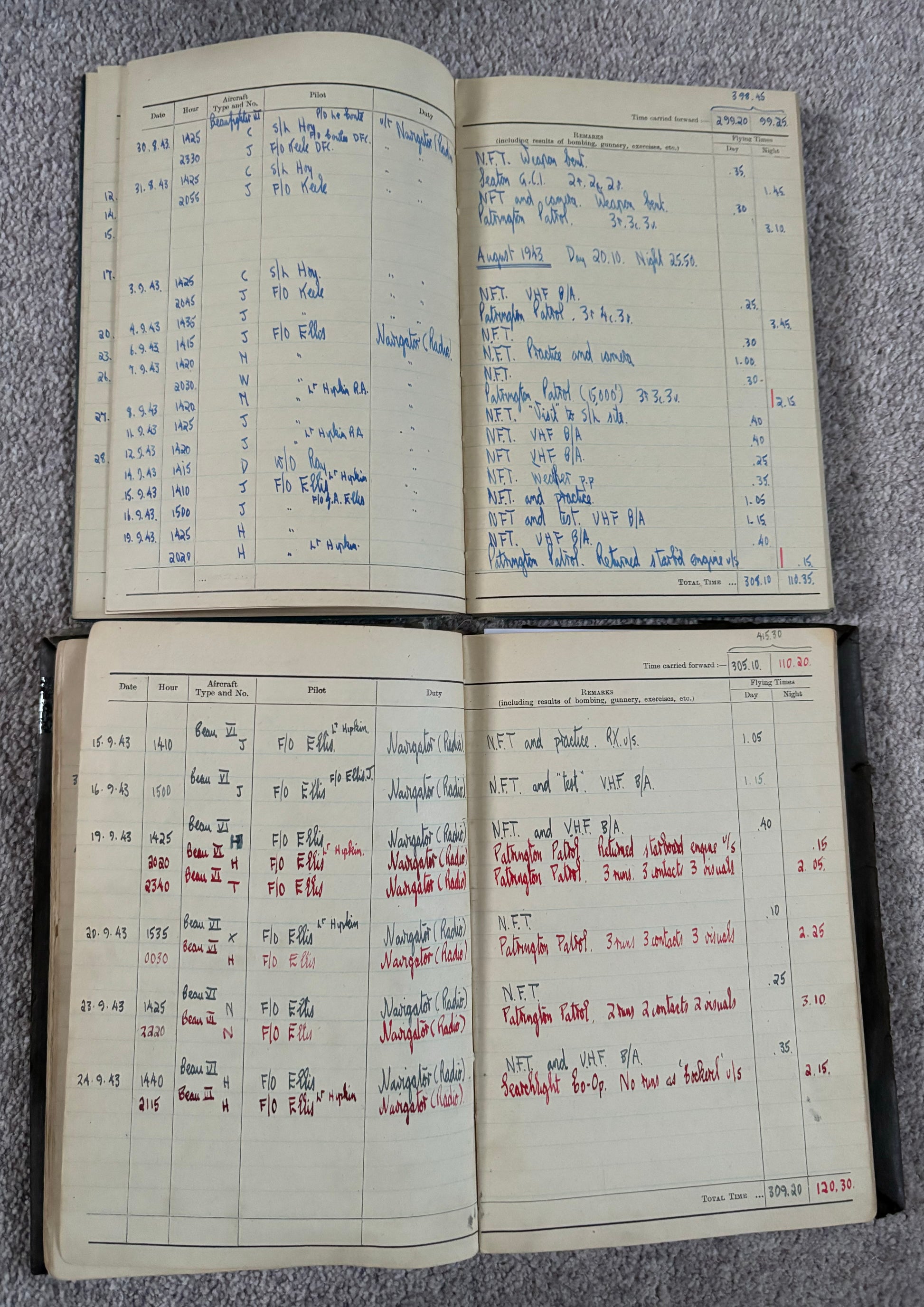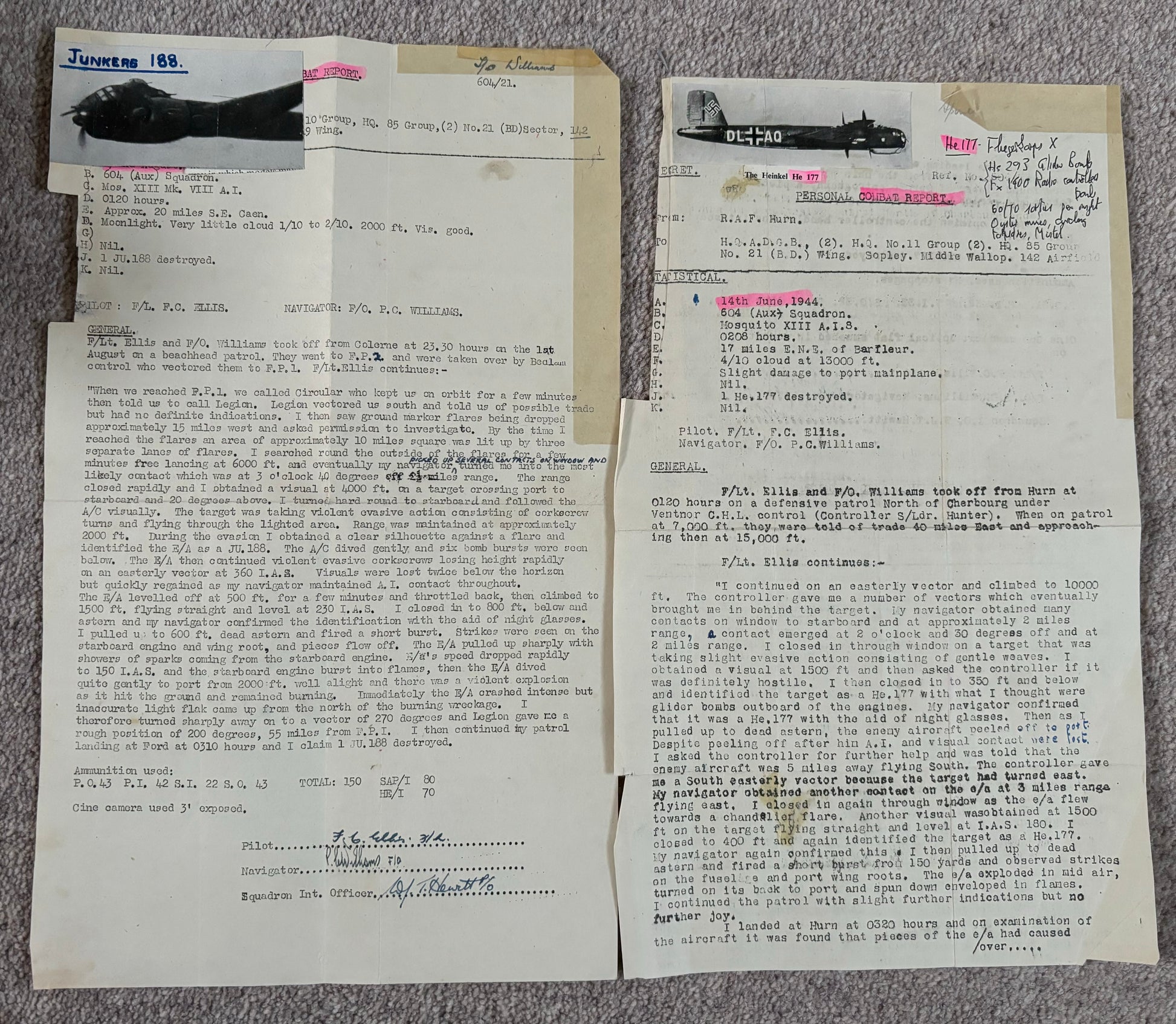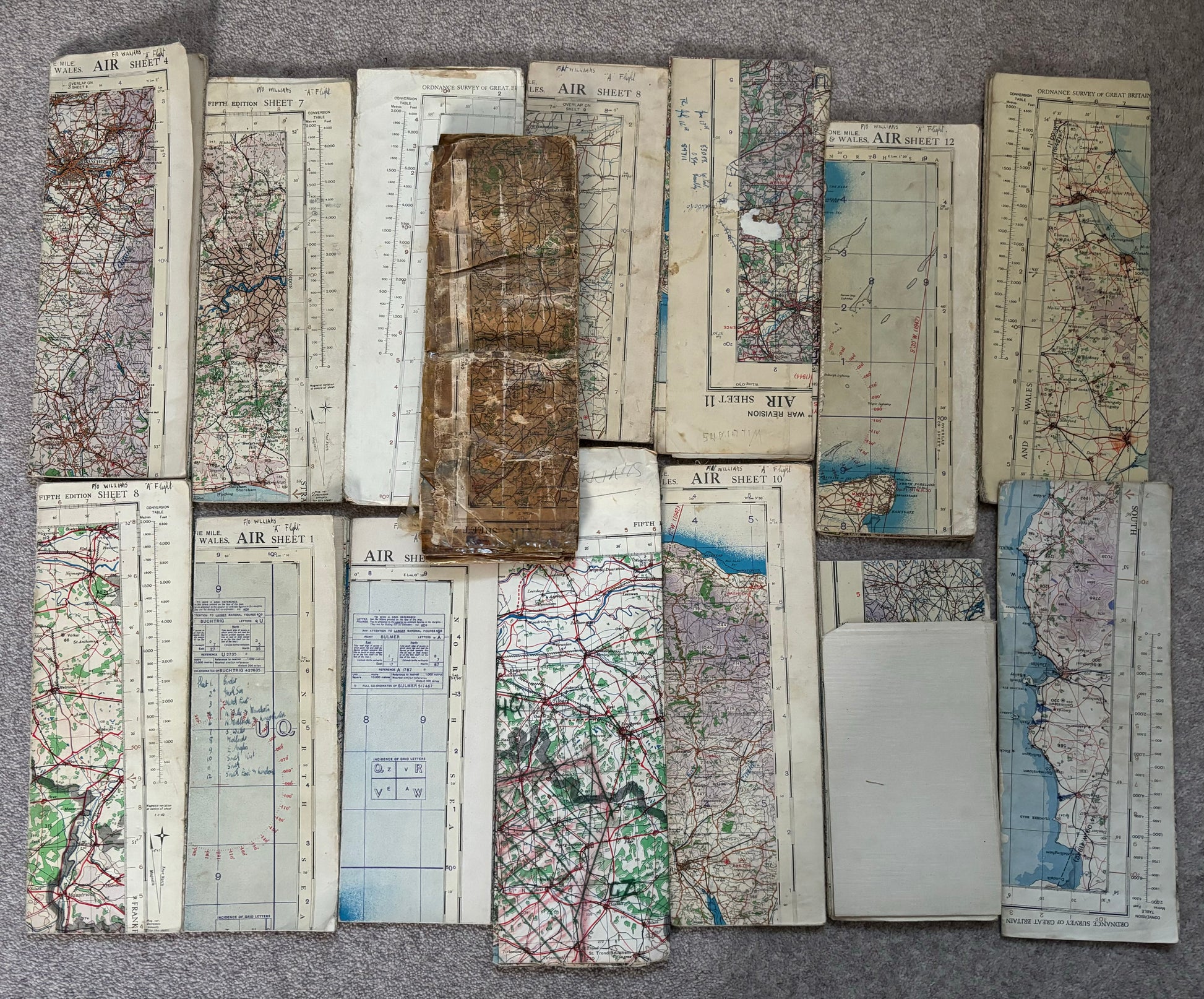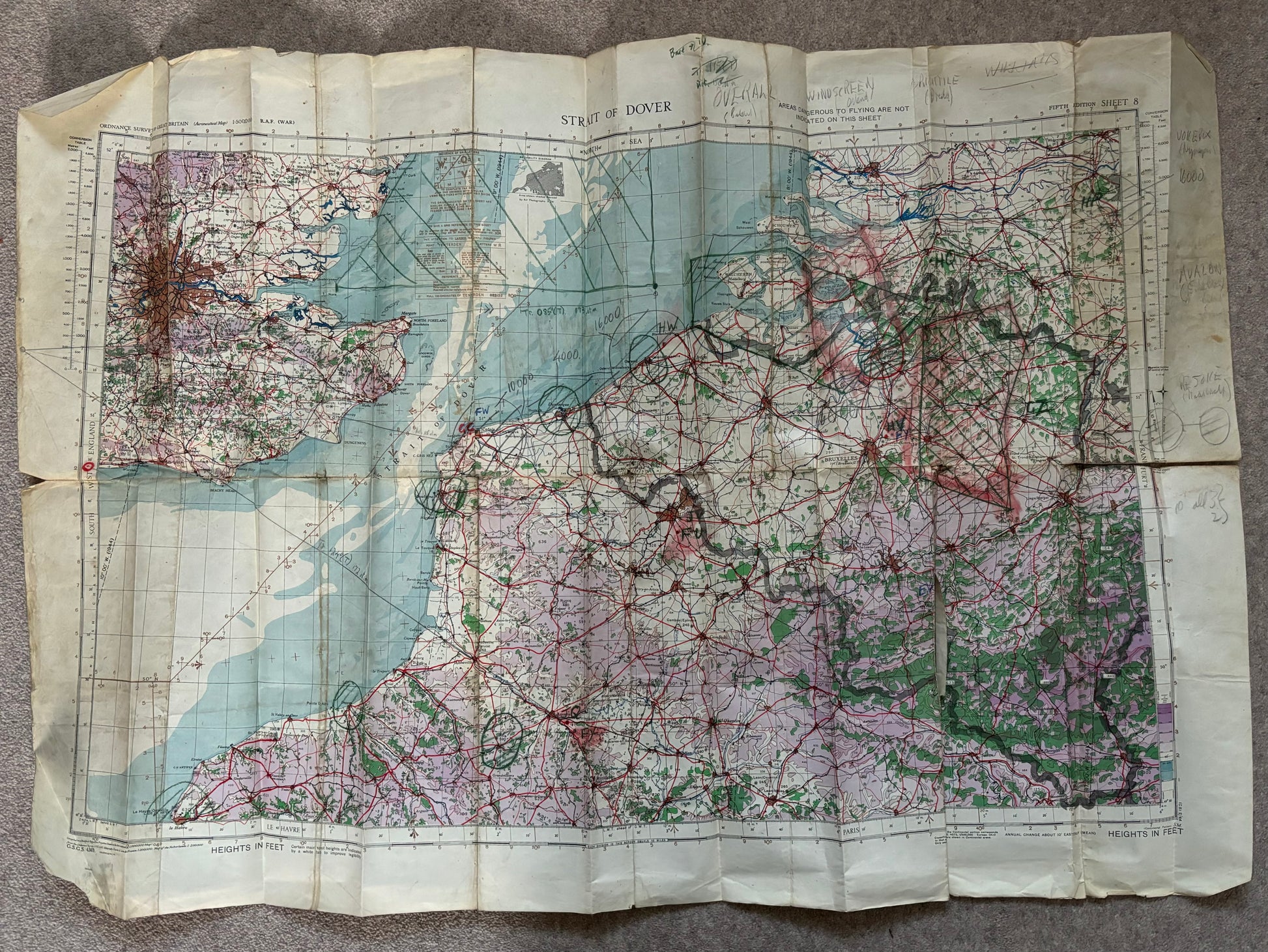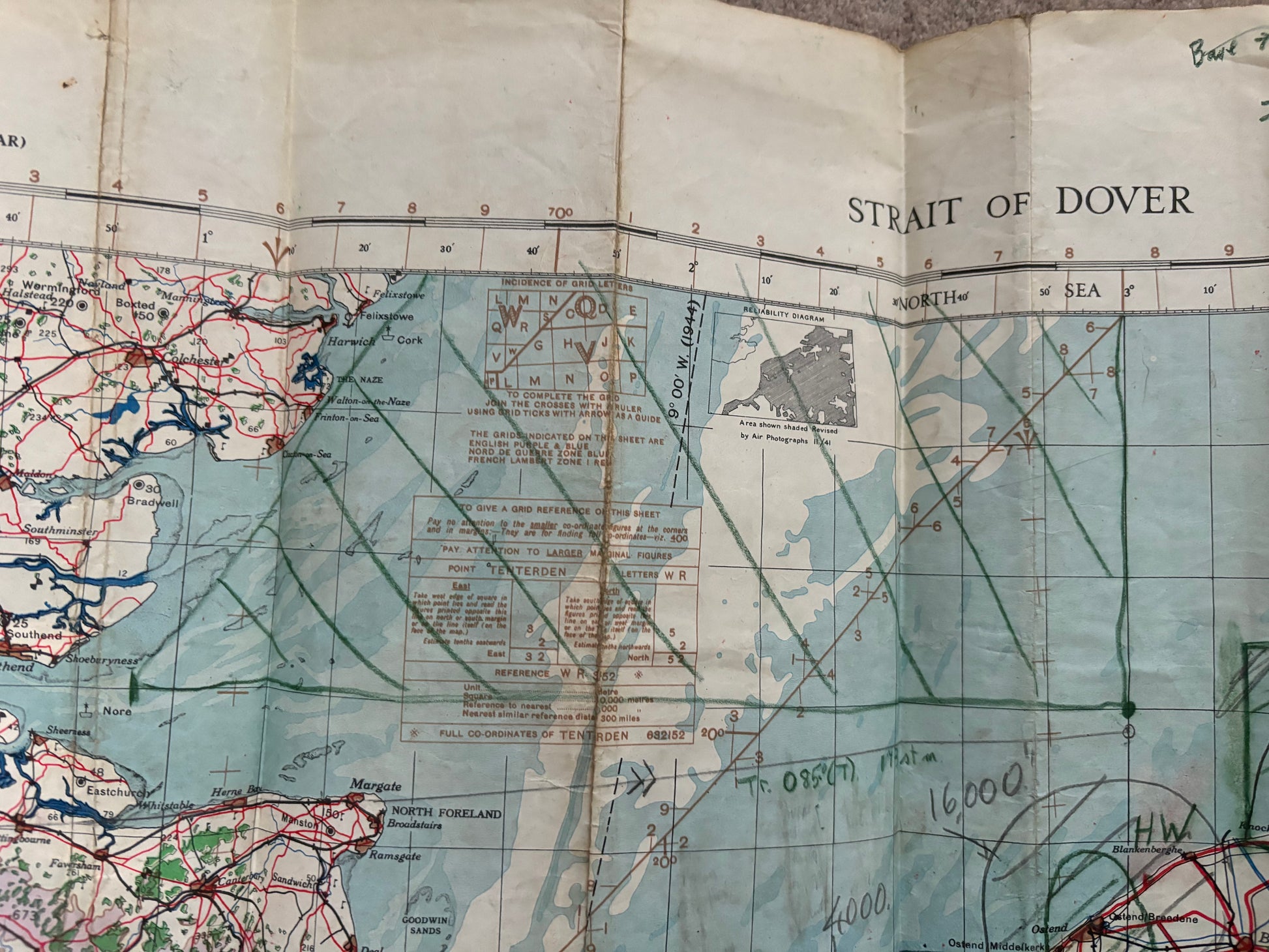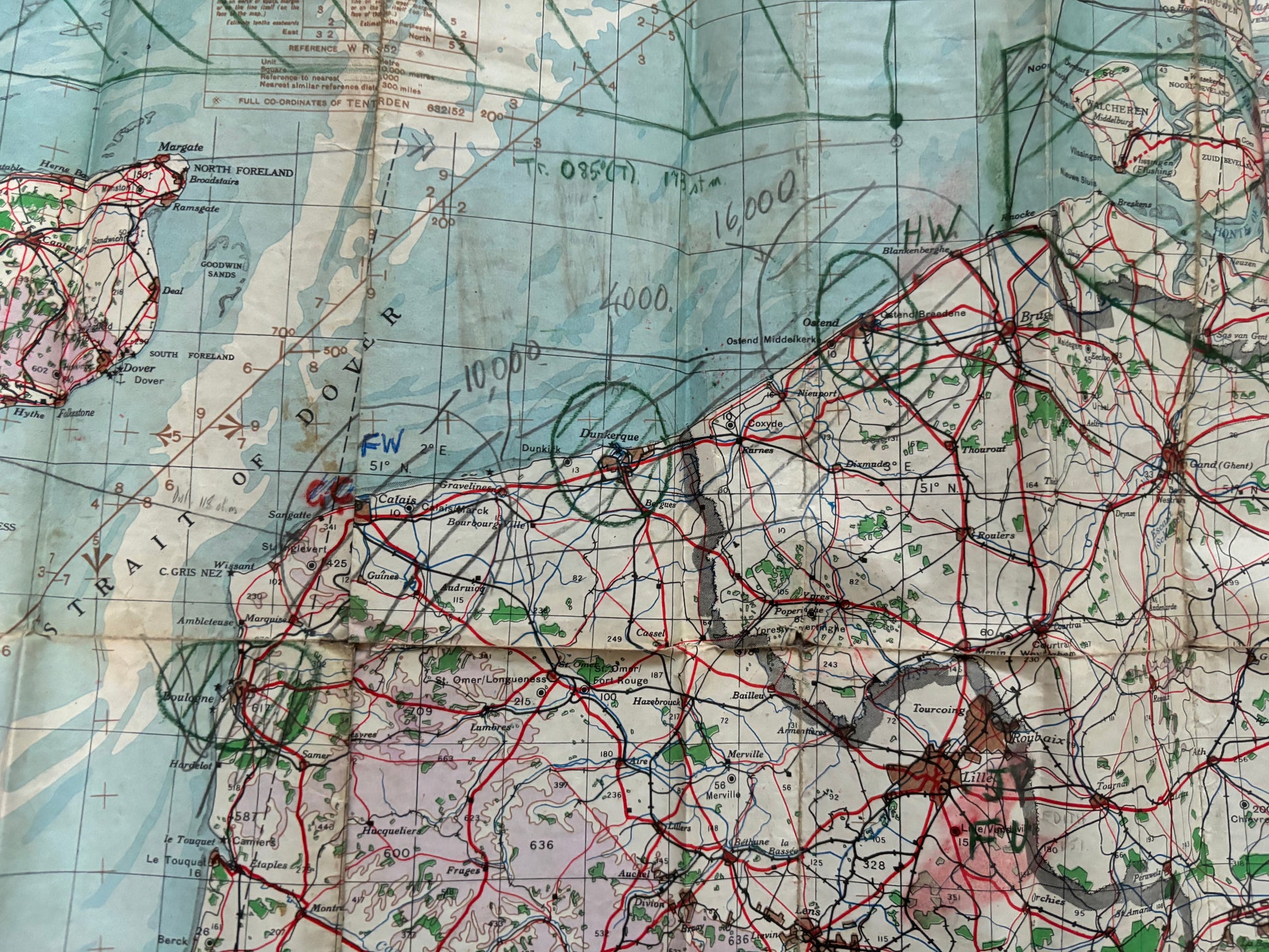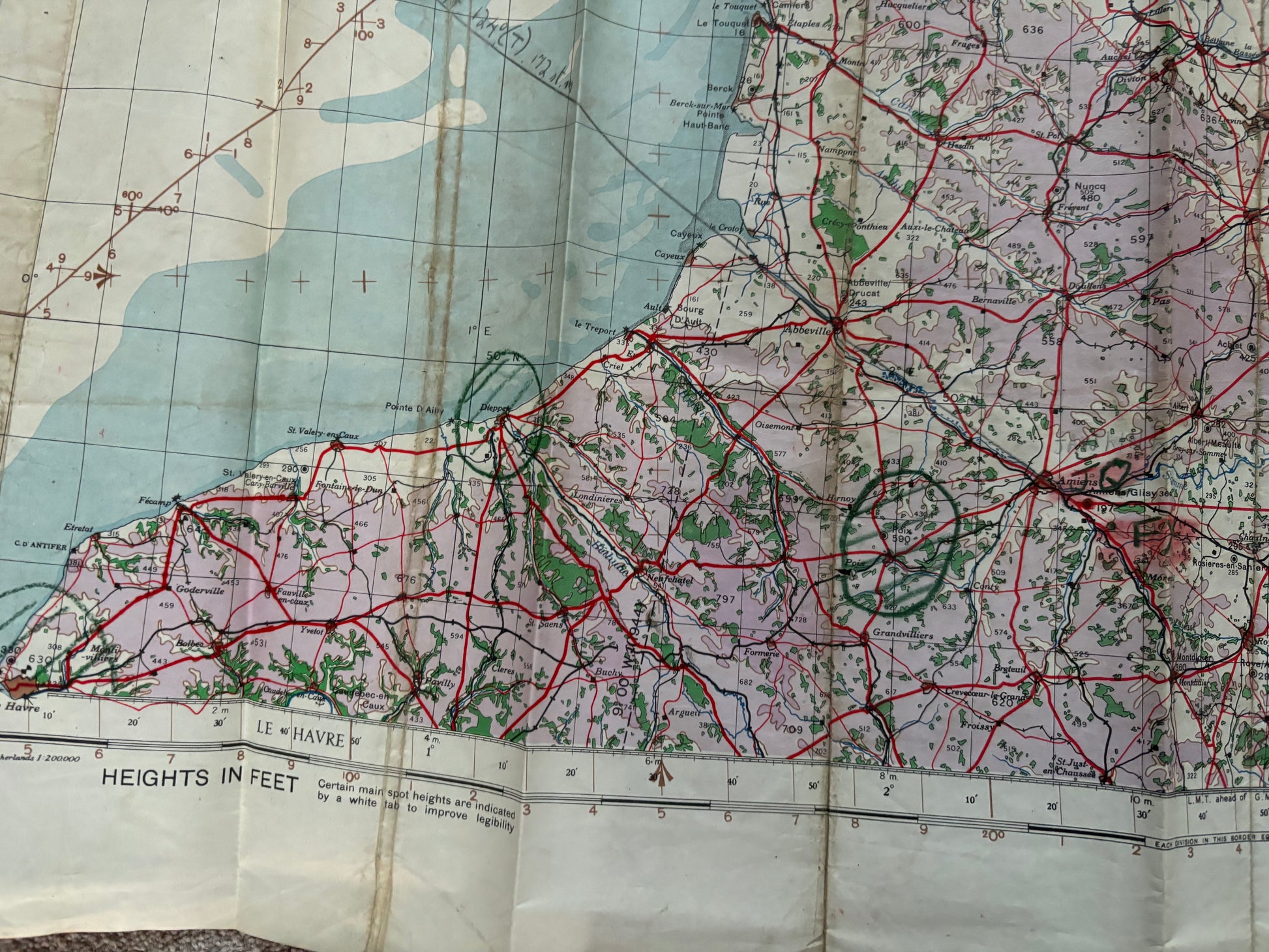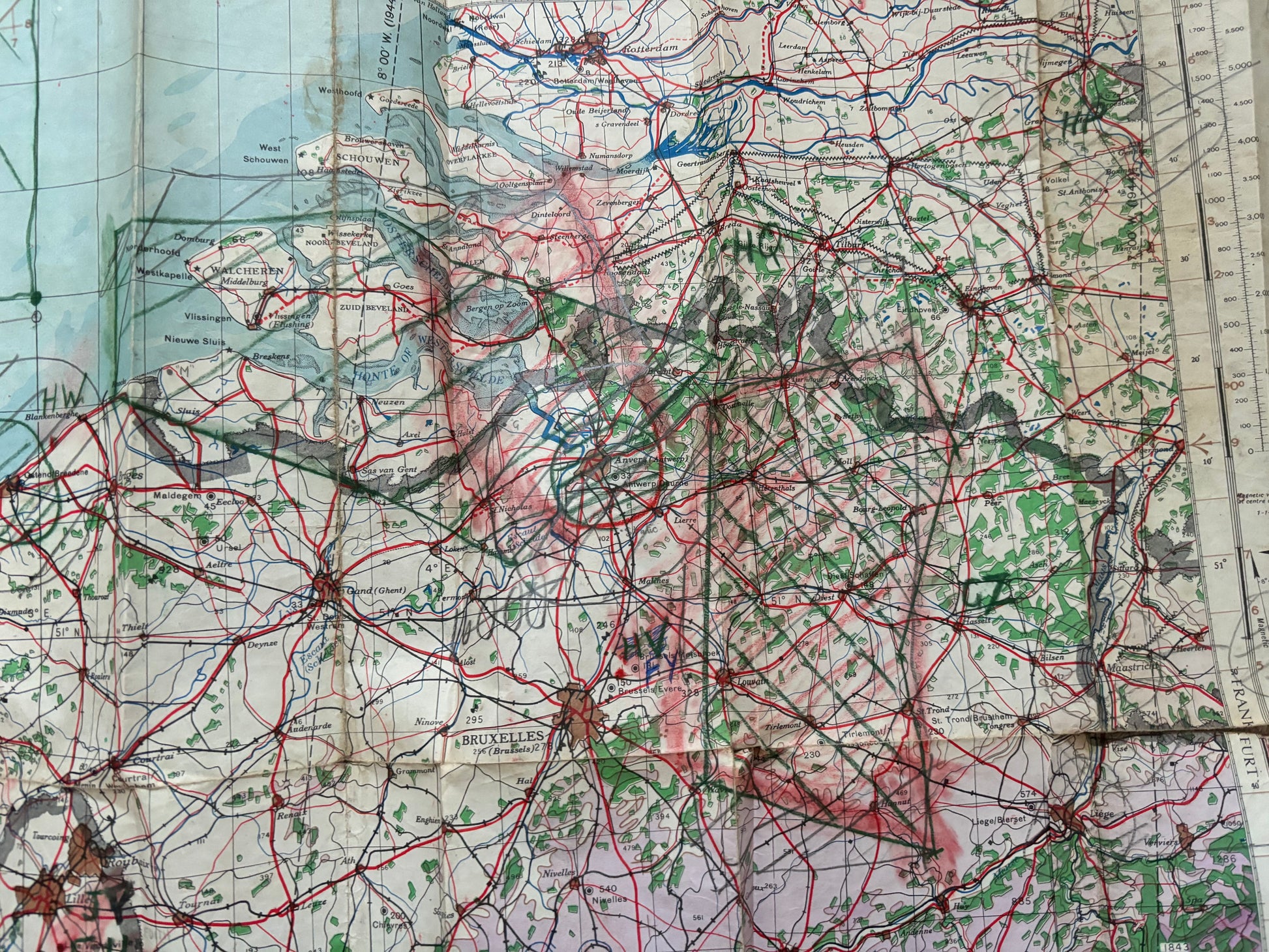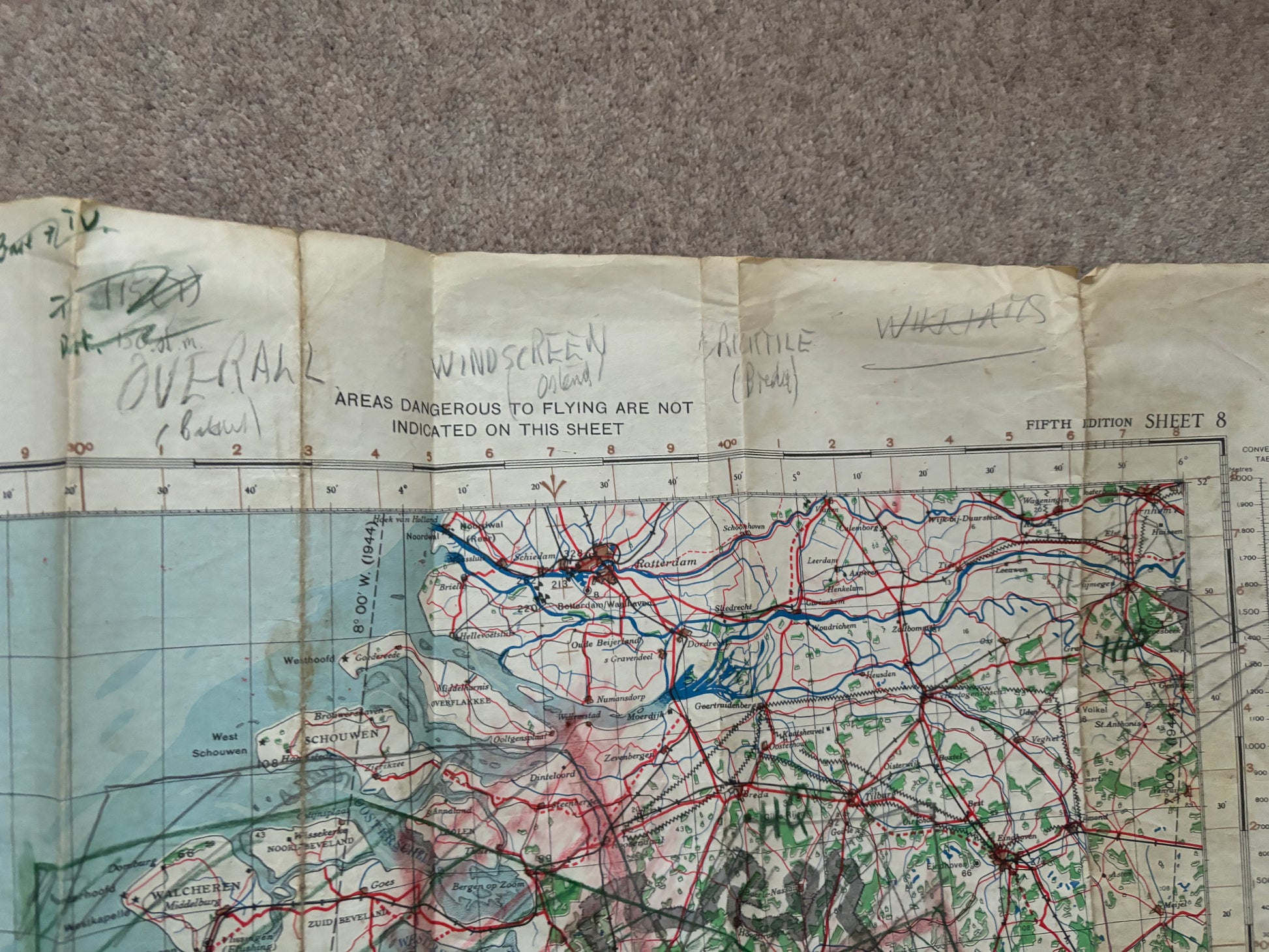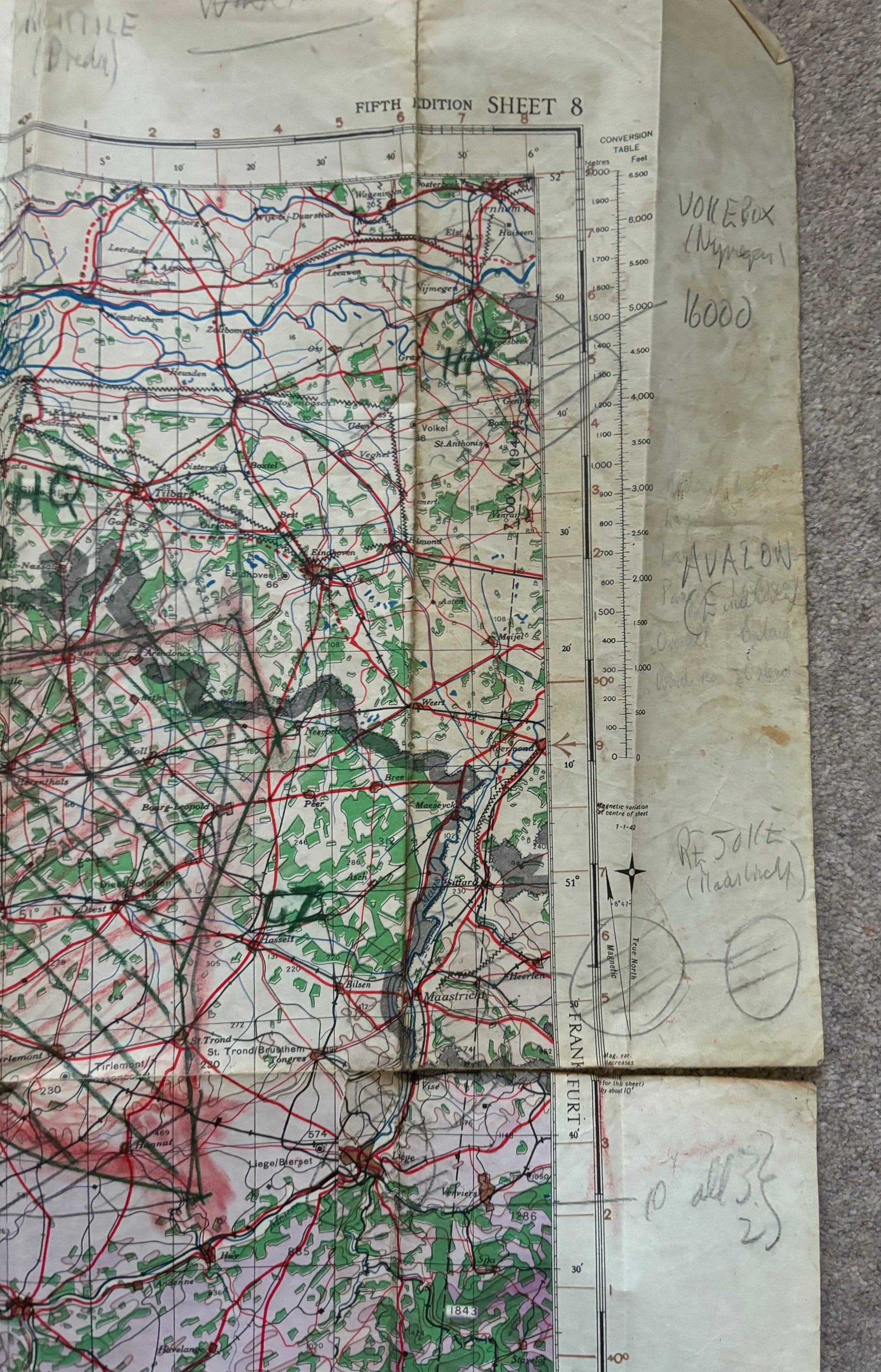SOLD! Incredibly Special Logbook Set to a Mosquito Night Fighter, 604 Squadron, 2 Confirmed Kills, D-Day, Battle of the Bulge, First Night Fighter Squadron into Normandy
SOLD! Incredibly Special Logbook Set to a Mosquito Night Fighter, 604 Squadron, 2 Confirmed Kills, D-Day, Battle of the Bulge, First Night Fighter Squadron into Normandy
Couldn't load pickup availability
A historically significant and incredibly special logbook set to Flight Lieutenant (Navigator) Peter Charles Williams, 604 Squadron, a Mosquito Night Fighter, with 2 confirmed kills and completed 63 night fighter mission. He flew on D-Day, the Battle of the Bulge, Operation Neptune and was part of the first Night Fighter unit into Normandy, operating from the beachheads. The logbooks are full of amazing details, a small sample of which is included in this description. Also included are his original operationally used Navigators maps, the combat reports for his two kills, a rare ‘Gouli Chit’ handout, newspaper cuttings, research and so much more.
Included in the set is:
· Two original logbooks, named to Williams, containing his entire career from early training, to his time as a nightfighter, to working as an instructor in mid 1945. It is important to stress these two logbooks contain the same details and are copies of each other, one being the official version, and the other private version with lots of annotations, cutouts and extra details not contained within the more brief official version. It should be mentioned the spine of the unofficial version has been poorly repaired, but is still very much readable. The logbooks over 153.05 operational hours as a nightfighter (13/8/43- 17/2/45), including 63 night fighter sorties, and 743.45 hours total. They include flights on D-Day, the Battle of the Bulge, Operation Neptune, many close calls and two confirmed kills. They really are quite special.
· 15 operationally marked navigators RAF issue silk backed maps named to Williams. These maps have bearings, no fly zones, heights and other hand drawn annotations, and were the very maps Williams used during operations. One map, with a route marked to Amiens, as well as frontlines in the Netherlands, was likely used during his 4/11/44 Amiens patrol as well as later mission under Voicebox, Avalon and Rejoice. The maps range from Scotland, Wales, Irish Sea, England, The Channel, Belgium/Netherlands and the French Coast. All maps except one are in good condition (One has been repaired and is somewhat fragile).
· The original two RAF combat reports for Williams’s two confirmed kills, marked SECRET.
· A rare original linen backed ‘Gouli Chit’, handout issued to Williams in February 1943, featuring translations into Arabic reading: “To all Arab Peoples. Greetings and peace be upon you. The bearer of this letter is an Officer of the British Government and a friend of all Arabs. Treat him well, guard him from harm, give him food and drink, help him to return to the nearest British soldiers and you will be liberally rewarded. Peace and mercy of God upon you. The British High Command in the East.”
· Three original newspaper cuttings mentioning Williams. As well as the original telegram mentioned in one of the articles, presented to him on his wedding day, granting him the rank of Pilot Officer.
· A collection of modern research, including newspaper articles, Gazette mentions, transcripts of the logbooks, and summaries of Peter’s service, as well as post war correspondence Peter himself had with various people and organisations. Also included is a photocopy of a page of the German logbook detailing the shooting down of Ju88 S-3, 330415, L1+NL of 3/LG 1-Ofw Bruno Harms.
Flight Lieutenant (Navigator) Peter Charles Williams (1585176, 160735)
604 Squadron, Mosquito Nightfighter, 2 Confirmed Kills, D-Day, Battle of Bulge
Flying Officer Peter Charles Williams was a native of Golders Green, London. He was educated at Haberdashers' Aske's School, Hampstead before joining the Royal Air Force in 1941. He was qualified as a Observer/Navigator (Radio) from 22/10/1942, training at No.6 AOS (Staverton), 62 OTU (Usworth, County Durham) and 54 OTU (Charter Hall & Winfield). In January 1943, he joined 604 Squadron, who were stationed at Predannack, Cornwall. At this stage he was flying mostly Bristol Beaufighter’s and Liberator II’s. He transferred to 301 FTU and No.1 OAD in February 1943 as a Flight Sergeant, running regular trips to Gibraltar and Cairo, (where he received the Gouli Chit flyer). He returned including one trip 25th- 28th April, with Flight Lieutenant Prchal, a Czech pilot who later in the war would become famous in July 1943 for piloting the Liberator that crashed killing General Sikorski, while escaping himself. Williams joined 271 Squadron in May 1945. On the 3rd August 1943 he transported a ‘Government Official’ DIRECT to Spain, one can only imagine who this was. On the 13th August 1943 he returned to 604 Squadron, stationed at Scorton, Yorkshire where he began his operational training as a nightfighter, which according to his logbook was very intense, going up on operational missions as a trainee in which several kills were achieved, including one which won his pilot, Flight Officer Keele, a DFC. He began formal operational flying with 604 squadron as a nightfighter on 7th September 1943, where he seemingly went on missions almost every night, including one instance on the 20th September where he went up twice in one night after returning from his first sortie with only one engine. On the 27th November 1943 he got married and commissioned as Pilot Officer on the same day, which was featured in an article by William Hickey, Daily Express, November 28th 1943:
“On Saturday I went to the wedding of a night fighter type. And I picked up the following surprising tips; 1. The bridegroom, a Flight Sgt, navigator, said he hadn’t told any of his colleagues about his pending marriage because the last one did, and they all ganged up on him, and painted the poor boy red, white and blue. 2. He revealed how sentimental and casual the RAF can be in its social moments. His wedding present was a telegram announcing that his commission as a Pilot Officer had come through retro-active to last June. Which was nice of somebody. But the boy had only the vaguest idea of how long his leave might be.”
Williams kept the telegram mentioned with his promotion in, which is included in the lot. On the 1st March 1944, the squadron were re-equipped with Mosquito XII and XIII nightfighters, which he flew his first operational mission in on the 9th March 1944. On the 17th March he is listed in the Gazette as being promoted to Flight Officer, backdated to the 24th December 1943. On the 2nd May 1944, 604 squadron were transferred to RAF Hurn, where they began their preparation for D-Day. Williams actually has the 5th June circled as D-Day on his logbook, as it was famously postponed a day. His entry for the 5th reads “Base-Colerne. Reserve for D Night patrols”. On D-Day itself Williams went up three times, including a night patrol of Caen, Bougy and Liseux. In the immidiete aftermath of D-Day, (06/6/44 to 01/8/44) Williams went on 19 nighfighter operations over the combat area/shipping lanes totalling 2 confirmed kills and 44.25 operational flying hours. On the 13th June 1944, Williams got his first confirmed kill, a Heinkel 177, whilst flying over Normandy, which was described in an article in the Star, June 14th 1944 reads:
“Londoners Get A Heinkel: The light of a chandelier flare guided a London night fighter crew to the destruction of a Heinkel near the Normandy beach-head during the night. The pilot, Flight-Lieut F. C. Ellis, of Ealing, said today ‘The Heinkel was patrolling the bay when we came upon him. He may have dropped the flare himself on a previous run. Anyway, we gave him about a three second burst and he exploded, turned over on to his back, and then spun down, still flaming.’ It was the first kill for Flight Lieut Ellis and his observer, Flying Officer Peter Williams, of Golders Green.”
The original combat report also included in the set submitted by Williams and Ellis reads:
“F/Lt Ellis and F/O Williams took off from Hurn at 01:20 hours on a defensive patrol north of Cherbourg under Ventnor CHL control (Controller S/Ldr Hunter). When on patrol at 7,000ft they were told of trade 40 miles East and approaching then at 15,000ft, F/Lt Ellis continues: ‘I continued on an easterly vector and climbed to 10,000ft. The controller gave me a number of vectors which eventually brought me in behind the target. My navigator obtained many contacts on window to starboard and at approximately 2 miles range a contact emerged at 2 o'clock and 30 degrees off and at 2 miles range. I closed in through window on a target that was taking slight evasive action consisting of gentle weaves. I obtained a visual at 1500 it and then asked the controller if it was definitely hostile. I then closed in to 350 ft and below and identified the target as a He177 with what I thought were glider bombs outboard of the engines. My navigator confirmed that it was a He177 with the aid of night glasses. Then as I pulled up to dead astern, the enemy aircraft peeled off to port. Despite pulling off after him A.I. and visual contact were lost. I asked the controller for further help and was told that the enemy aircraft was 5 miles away flying South. The controller gave me a south easterly vector because the target had turned east. My navigator obtained another contact on the e/a at 3 miles range flying east. I closed in again through window as the e/a flew towards a chandelier flare. Another visual was obtained at 1500ft on the target flying straight and level at I.A.S. 180. I closed to 400 ft and again identified the target as a He.177. My navigator again confirmed this. I then pulled up to dead astern and fired a short burst from 150 Yards and observed strikes on the fuselage and port wing roots. The e/a exploded in mid air, turned on its back to port and spun down enveloped in flames. I continued the patrol with slight further indications but no further joy. I landed at Hurn at 03:20 hours and on examination of the aircraft it was found that pieces of the e/a had caused damage to the leading edge of the port mainplane. Pieces of Perspex were removed from the main plane and in the radiation were found pieces of German astrograph, a piece of blue grey fabric and strips of window. In my opinion the controller handled the interception perfectly. I clam 1 He177 destroyed.’”
According to German logs, the aircraft was likely He177 A-5, 550146 of 4/KG-Oblt Benno Meissner (shot down Carentan, 02:00 hours). On the 1st August 1944, Williams got his 2nd confirmed kill, a Junkers 188, whilst flying near Caen on beachhead patrol. The original combat report also included in the set submitted by Williams and Ellis reads:
“F/Lt Ellis and F/O Williams took off from Colerne at 23:30 hours on the 1st August on beachhead patrol. The went to FP2 and were taken over by Bedlam control who vectored them to FPL. F/lt Ellis continues: ‘When we reached FPL we called Circular who kept us on orbit for a few minutes then told us to call Legion. Legion vectored us south and told us of possible trade but had no definite indications. I then saw ground marker flares being dropped approximately 15 miles west and asked permission to investigate. By the time I reached the flares an area of approximately 10 miles square was lit up by three separate lanes of flares. I searched round the outside of the flares for a few minutes free landing at 6000 feet, and eventually my navigator picked up several contacts on window and turned me into the most likely contact which was at 3 o’clock 40 degrees off a miles range. The range close rapidly and I obtained a visual at 4000 feet on a target crossing port to starboard and 20 degrees above. I turned hard round to starboard and followed the A/C visually. The target was taking violent evasive action consisting of corkscrew turns and flying through the lighted area. Range was maintained at approximately 2000ft. During the evasion I obtained a clear silhouette against a flare and identified the E/A as a JU188. The A/C dived gently and six bomb bursts were seen below. The E/A then continued violent evasive corkscrews losing height rapidly on an easterly vector at 360 IAS. Visuals were lost twice below the horizon but quickly regained as my navigator maintained AI contact throughout. The E/A levelled off at 500ft for a few minutes and throttled back, then climbed to 1500ft, flying straight and level at 230 IAS. I closed in to 800ft below and astern and my navigator confirmed the identification with the aid of night glasses. I pulled up to 600ft dead astern and fired a short burst. Strikes were seen on the starboard engine and wing root, and pieces flew off. The E/A pulled up sharply with showers of sparks coming from the starboard engine. E/A’s speed dropped rapidly to 150 IAS and the starboard engine burst into flames, then the E/A dived quite gently to port from 2000ft, well alight and then there was a violent explosion as it hit the ground and remained burning. Immediately the E/A crashed intense but inaccurate light flak cane up from the north of the burning wreckage. I therefore turned sharply away on to a vector of 270 degrees and Legion gave me a rough position of 200 degrees, 55 miles from FPI. I then continued my patrol landing at Ford at 03:10 hours and I claim 1 JU188 destroyed.’”
According to German logs the aircraft shot down was actually likely an Ju88 S-3 (rather than a 188), most likely Ju88 S-3, 330415, L1+NL of 3/LG 1-Ofw Bruno Harms (Shot down in flames 15 kms south of Caen, crashed near Rocquancourt). Shortly after, Williams le the Limestone Red Section across the channel to become the first nightfighter squadron into Normandy, landing at Picauville, American Beachhead, on the 06/8/44. He also operated out of Carpiquet, British Beachhead, from the 09/9/44, still supporting the British troops in Normandy. They were then posted to Ford, Sussex in November and Odiham shortly after, providing air support for the Northern flank, particularly Amiens, Ostend and the Scheldt. They then shifted focus in December, providing air support for the American during the Battle of the Bulge, Williams’ entry for 23rd December reads “Patrol under Marmite GCI (Yanks) in Liege area. Chased two divers. No luck.”. He then flew several missions over Holland and Germany before flying his last operational flight on 17/2/45. By the end of his tour, Williams had over 153.05 operational hours as a nightfighter (13/8/43- 17/2/45), and 743.45 hours total, 476.25 of which were alongside F/Lt Ellis. He flew 63 nightfighter missions. His return to England was noted in the local papers with one paper dated 30th March 1945 reporting:
“Golders Green Man Shares in Two Kills, Observer in Mosquito Squadron: 'A Golders Green Mosquito nightfighter observer who has shared in the destruction of two enemy aircraft since D-Day, has recently finished a tour of operations with the Continental based RAF 2nd TAF County of Middlesex (Auxiliary) Squadron, and is now in England. He is Flying Officer Peter Charles Williams, of Litchfield way, Golders Green, who joined the RAF in September 1941. And started operational flying in the summer of 1943. It was soon after D-day when his squadron, the first night-fighter unit to fly from a landing strip on France, was engaged in giving night air cover to our troops fighting inland from the beaches, that Williams helped his pilot to destroy a four-engined Heinkel 177 over the sea. In August came his second victory, when a Ju. 188 fell to the Mosquito's guns. Flying Officer Williams and his pilot Flight Lieutenant F.C. Ellis of West Ealing, were latterly the only all-Middlesex crew flying with the County of Middlesex Squadron. A building surveyor before he volunteered for the RAF, Williams, who is 23, was educated at Haberdashers’ Aske’s School, Hampstead”
Upon returning to England he trained to become an instructor at 62 OTU (Ouston, Newcastle) and 54 OUT (Charter Hall). In July 1945 he was awarded the rank of Flight Lieutenant, becoming an instructor at GCA School, RAF Atherstone.
|
Date |
Time |
Aircraft |
Pilot |
Duty |
Remarks |
Flying Times |
|
25/4/43 |
00:00 |
Liberator II (511 Sqd, AL 616) |
F/lt Prchal |
Passenger |
Cairo West- Gibraltar |
4.40 (day), 6.30 (night) |
|
02/8/43- 4/8/43 |
17:15 07:35 12:00 |
Beaufighter VI (MM924) |
F/O Ellis |
Navigator |
Lyneham- Portreath- Gibraltar- Ras El ma (Government Official- DIRECT [Spain]) |
.55 + 5.20 + 1.25 (day) |
|
14/8/43 |
23:40 |
Beaufighter VI (H) |
F/O Keele |
Pupil Navigator (radio) |
Searchlight Co. Op. 1 “kill” |
1.55 (night) |
|
15/8/43 |
22:25 |
Beaufighter VI (C) |
F/O Keele |
Pupil Navigator (radio) |
Seaton GCI + Bullseye. 1 run, 1 contact, 1 visual |
2.00 (night) |
|
22/8/43 |
23:59 |
Beaufighter VI (J) |
F/O Keele |
Pupil Navigator (radio) |
Seaton GCI + Bullseye. 2 “kills” (It seems Keele won a DFC for this patrol) |
1.30 (night) |
|
07/9/43 |
20:30 |
Beaufighter VI (W) |
F/O Ellis |
Navigator (Radio) |
Patrington patrol (15,000’). 3 runs, 3 contacts, 3 visuals (First formally operational flight as a fully qualified nightfighter) |
2.15 (night) |
|
19/9/43 |
20:20 23:40 |
Beaufighter VI (H) Beaufighter VI (T) |
F/O Ellis |
Navigator (Radio) |
Patrington patrol. Returned, starboard engine u/s. Patrington patrol. 3 runs. 3 contacts. 3 visuals. |
.15 (night 2.05 (night) |
|
12/11/43 |
21:30 |
Beaufighter VI (A) |
F/O Ellis |
Navigator (Radio) |
Patrington Patrol. Dogfigt with Mosquito (25). Full moon. |
3.00 (night) |
|
22/11/43 |
18:30 |
Beaufighter IV (M) |
F/O Ellis |
Navigator (Radio) |
“Bullseye” Searchlight Co-Op. Self Smacking from “L”. No joy. Freelance run only. 1 visual. |
2.10 (night) |
|
27/11/43 |
N/A |
N/A |
N/A |
N/A |
Married & Commissioned |
N/A |
|
10/1/44 |
19:05 |
Beaufighter IV (H) |
F/O Ellis |
Navigator (Radio) |
Seaton GCI Bomber Co-op. 3 kills. 1 Lancaster, 1 Wellington, 1 Halifax (19,000’). Dogfight with Lancaster. |
2.25 (night) |
|
03/2/44 |
21:45 |
Beaufighter IV ((D) |
F/O Ellis |
Navigator (Radio) |
Seaton GCI. Bomber Co-op. 3 Lancs, 1 Wimpey, 1 Beau at 14-20,000ft!!! 5 runs, 5 contacts, 5 visuals |
2.20 (night) |
|
06/2/44 |
19:10 |
Beaufighter IV ((D) |
F/O Ellis |
Navigator (Radio) |
Catfoss GCI (Mobile) Dogfights in moonlight with M-T. 3 runs, 7 contacts, 5 visuals. |
2.00 (night) |
|
31/3/44 |
03:35 |
Mosquito XII (J) |
F/O Ellis |
Navigator (Radio) |
Scramble S/L’s “F” and “F0b7”. 1 Bogey- Lancaster landed Bradwell Bay |
1.45 (night) |
|
11/4/44 |
23:20 |
Mosquito XII (D) |
F/O Ellis |
Navigator (Radio) |
Bomber Co-op. S/L aided interceptions from Hull to Newcastle. Complete Shambles!!! |
1.15 (night) |
|
27/4/44 |
21:40 |
Mosquito XII (D) |
F/O Ellis |
Navigator (Radio) |
Practice “Ranger” X Country. Base-Filey-Cromet Lt- Wells- Wittering- Holesworth (Patrol, 2 kills)- Skegness- Sea- Hornsea- Base. Downward vis poor. |
2.40 (night) |
|
05/6/44 |
14:20 |
Mosquito XIII (B) |
F/Lt Sanderman |
Navigator |
Base- Colerne. Reserve for D Night patrols. |
|
|
06/6/44 |
07:30 16:20 23:00 |
Mosquito XIII (D) |
F/O Ellis |
Navigator (Radio) |
Colerne- Base N.F.T. F.P.2 then diverted to Patrol “C” South of Caen- Bougy- Liseux. No joy. |
.20 (day) .15 (day) 2.40 (night) |
|
09/6/44 |
23:20 |
Mosquito XIII (D) |
F/O Ellis |
Navigator (Radio) |
Shipping patrol. Fired at after. Investigating flares. |
2.10 (night) |
|
13/6/44 |
01:20 |
Mosquito XIII (D) |
F/Lt Ellis |
Navigator (Radio) |
Shipping patrol (Ventnor CHL). He 177 destroyed, 17m ENE of Barfleur, Normandy. (First Confirmed Kill) |
2.40 (night) |
|
17/6/44 |
23:00 |
Mosquito XIII (D) |
F/Lt Ellis |
Navigator (Radio) |
Shipping patrol (Ventnor CHL) Several chases. All friendlies including 2 Typhoones (not P Planes as hoped) |
2.20 (night) |
|
18/6/44 |
00:45 |
Mosquito XIII (D) |
F/Lt Ellis |
Navigator (Radio) |
Fighter Pool 2, diverted to Patrol D. Lessay-Vire. Large fires seen but no joy. |
2.50 (night) |
|
30/6/44 |
22:30 |
Mosquito XIII (N) |
F/Lt Ellis |
Navigator (Radio) |
Fighter Pool 1 and all GCI’s went!!! 2 chases after Huns but no contact. 300’ cloud base on return. |
2.40 (night) |
|
19/7/44 |
23:45 |
Mosquito XIII (R) |
F/Lt Ellis |
Navigator (Radio) |
Fighter Pool 2. 1 friendly (Fortress). Returned port engine u/s |
2.10 (night) |
|
01/8/44 |
23:25 |
Mosquito XIII (T) |
F/Lt Ellis |
Navigator (Radio) |
Fighter Pool 2 then to Fighter Pool 1. Junkers 188 destroyed 15m SSW of Caen. Diverted to Ford Hydraulics u/s. Pumped o/cs flaps down. (Second Confirmed Kill) |
3.25 (night) |
|
04/8/44 |
01:25 |
Mosquito XIII (E) |
F/Lt Ellis |
Navigator (Radio) |
Fighter Pool 2. 30 miles North pf Cherbourg!! 1 friendly (Beaufighter X) |
3.00 (night) |
|
05/8/44 |
01:30 |
Mosquito XIII (B) |
F/Lt Meadows |
Navigator (Radio) |
Fighter Pool 2, Operation Neptune “Sweet F. A.” |
2.50 (night) |
|
06/8/44 |
11:25 |
Mosquito XIII (B) |
F/Lt Meadows |
Navigator (Radio) |
Leader of Limestone Red Section. Colerne- Picauville (First Nightfighter Squadron into Normandy) |
1.00 (day) |
|
13/8/44 |
21:55 |
Mosquito XIII (Z) |
F/Lt Ellis |
Navigator (Radio) |
Patrol under “Tailcoat”. 5 mins continuous window. No contact. Informed window from friendly. |
3.05 (night) |
|
10/9/44 |
21:00 |
Mosquito XIII (D) |
F/Lt Ellis |
Navigator (Radio) |
1st patrol under “Tailcoat”. Cherboug area. P1’s 4r, 4c, 4v. |
3.20 (night) |
|
11/9/44 |
21:10 |
Mosquito XIII (E) |
F/Lt Ellis |
Navigator (Radio) |
1st patrol under “Yardley I” Cherboug area. P1’s PP. Very close (30’) with 31’. 3r, 3c, 3v. |
2.45 (night) |
|
4/11/44 |
19:20 |
Mosquito XIII (D) |
F/Lt Ellis |
Navigator (Radio) |
Amiens Patrol with “Legion”. Near thing (10’) with 38. P1’s 2r, 2c, 2v. |
2.45 (night) |
|
17/12/44 |
15:55 |
Mosquito XIII (T) |
F/Lt Ellis |
Navigator (Radio) |
1st Patrol of Scheldt estuary. Daylight. Duff weapon |
2.50 (night) |
|
23/12/44 |
04:55 |
Mosquito XIII (K) |
F/Lt Ellis |
Navigator (Radio) |
Patrol under Marmite GCI (Yanks) in Liege area. Chased two divers. No luck. (Battle of the Bulge) |
3.10 (night) |
|
24/12/44 |
16:55 |
Mosquito XIII (X) |
F/Lt Ellis |
Navigator (Radio) |
1st Patrol Eindhoven area. Sector control only |
3.00 (night) |
|
17/1/45 |
22:10 |
Mosquito XIII (L) |
F/Lt Ellis |
Navigator (Radio) |
1st Patrol under ‘Avalon’ (LWS) Dusseldorf- Cologne. Diverted via Cambrai/Epernay to Manston “on runway”! |
3.45 (night) |
|
29/1/45 |
16:55 |
Mosquito XIII (D) |
F/Lt Ellis |
Navigator (Radio) |
1st Patrol under “Voicebox (Nijmegen) 15,000ft NW of Gladbreck. Scrambled early. Daylight formation. Friendlies! |
2.35 (night) |
|
01/2/45 |
01:00 |
Mosquito XIII (D) |
F/Lt Ellis |
Navigator (Radio) |
Patrol under “Voicebox” (Nijmegen) 15000 N of Dorsten. 2 chases 28000 and 4000. Both friendlies before contact. |
3.00 (night) |
|
02/2/45 |
17:25 |
Mosquito XIII (D) |
F/Lt Ellis |
Navigator (Radio) |
1st Patrol under ‘Rejoice’ (Maastricht) 10,000 Daylight formation with 410 sqd. A/C between Roermond and Vento. Later alone under Bricktile (Breda), NE of Rotterdam |
2.40 (night) |
|
08/5/45 |
N/A |
N/A |
N/A |
N/A |
VE Day- CYCLE RIDE (Party to Digs, Curtains Bomber) |
N/A |
Share
